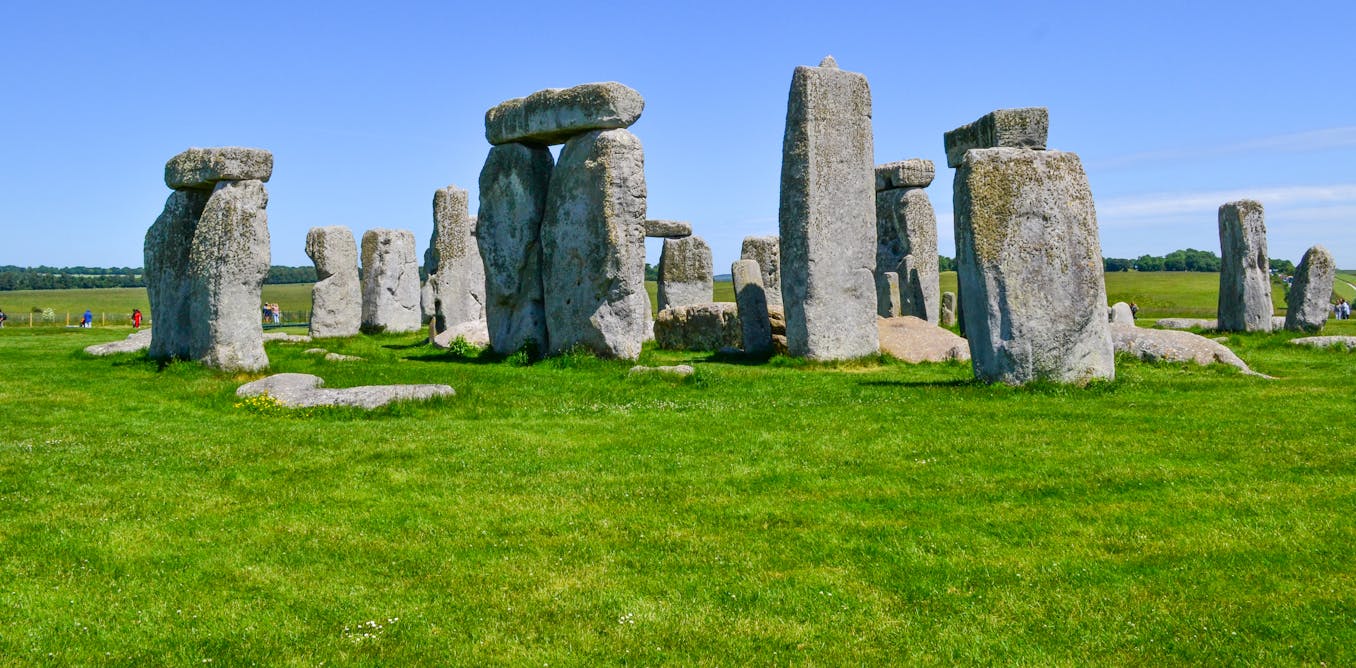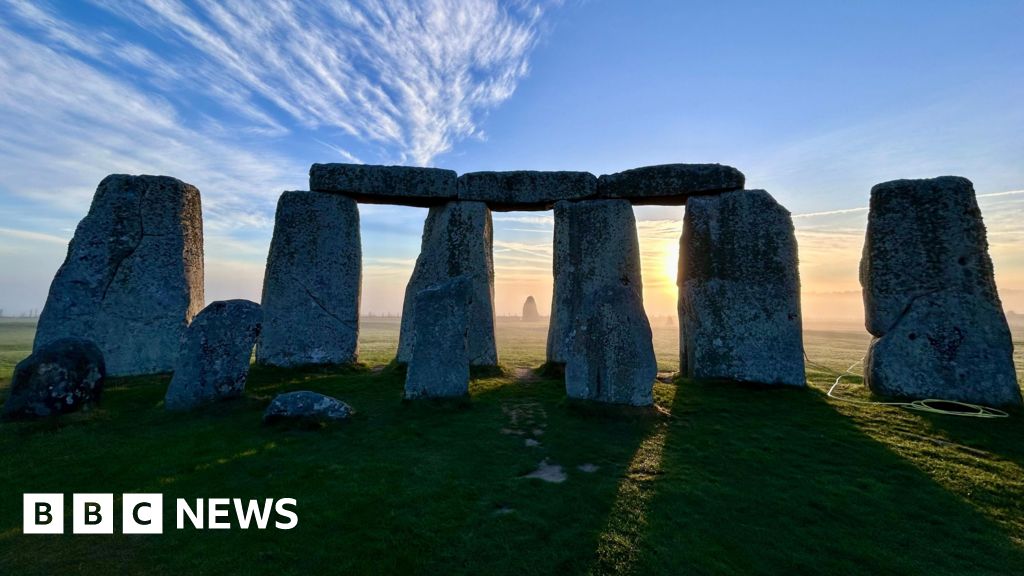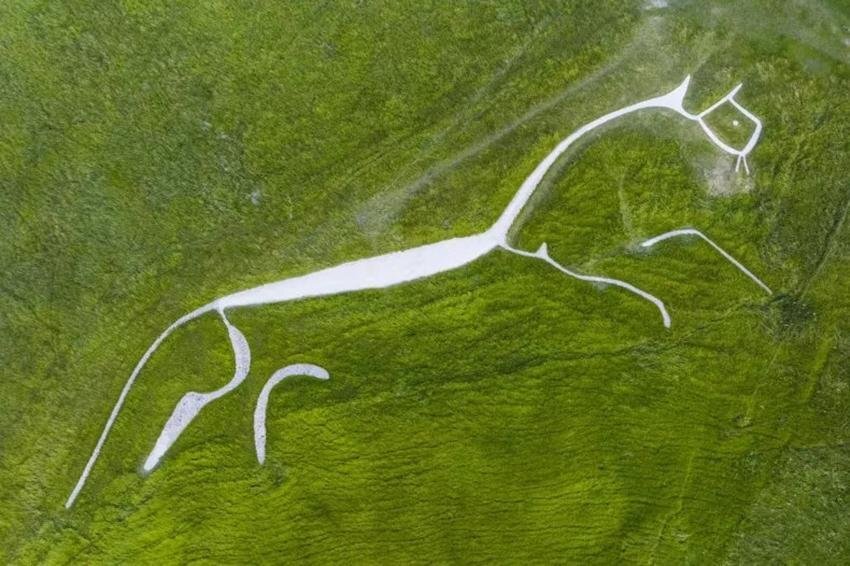Sidebar
British Archaeology
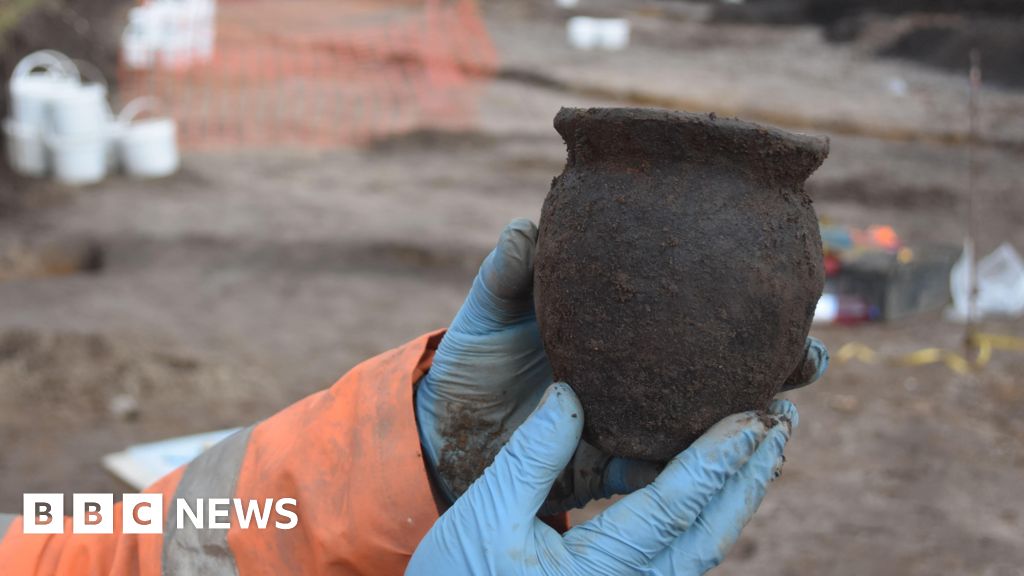 www.bbc.com
www.bbc.com
> Archaeologists have uncovered "significant" Anglo-Saxon finds across Holderness as cables are laid for the Dogger Bank offshore wind farm. > >The discoveries include remnants of an Anglo-Saxon long hall structure between Beeford and Skipsea, as well as artefacts from a site in Ulrome. > >The findings indicate Anglo-Saxons probably lived and farmed in this landscape over multiple phases between the 5th and 11th centuries. > >Community engagement manager for Dogger Bank Wind Farm, Rachel Lawrence, said: "Safeguarding historical evidence has been a critical part of our preparation work on Dogger Bank Wind Farm." > >She added: "We’re delighted we’re now able to share these exciting findings with the people who live in the towns and villages where this work was undertaken." > > ... > > The early medieval discoveries were unearthed by archaeologists working on a 30km corridor that houses the underground cables transmitting energy from Dogger Bank Wind Farm in the North Sea to the wind farm’s two onshore stations near Beverley. > >Archaeologists described the finds as a "regionally-significant discovery". > >Project manager for AOC Archaeology, Rebecca Jarosz- Blackburn, said the most "surprising and rewarding discovery" was the Anglo-Saxon long hall and associated field systems recorded near Beeford, which she said "represents some of the most extensive evidence from the period in the Holderness region".
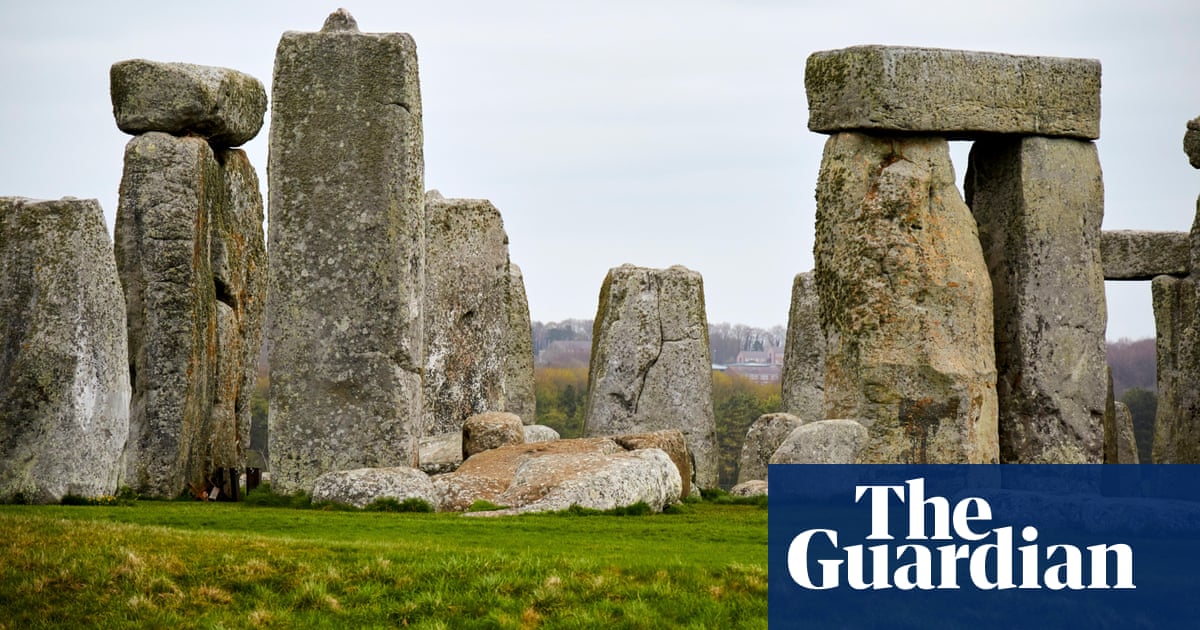 www.theguardian.com
www.theguardian.com
"The plot has thickened on the mystery of the altar stone of Stonehenge, weeks after geologists sensationally revealed that the huge neolithic rock had been transported hundreds of miles to Wiltshire from the very north of Scotland. That discovery, described as “jaw-dropping” by one of the scientists involved, established definitively that the six-tonne megalith had not been brought from Wales, as had long been believed, but came from sandstone deposits in an area encompassing the isles of Orkney and Shetland and a coastal strip on the north-east Scottish mainland. Many experts assumed that the most likely place of origin was Orkney, based on the islands’ rich neolithic culture and tradition of monument building. But a separate academic study has now found that Orkney is not, in fact, the source of the altar stone, meaning the tantalising hunt for its place of origin goes on..."
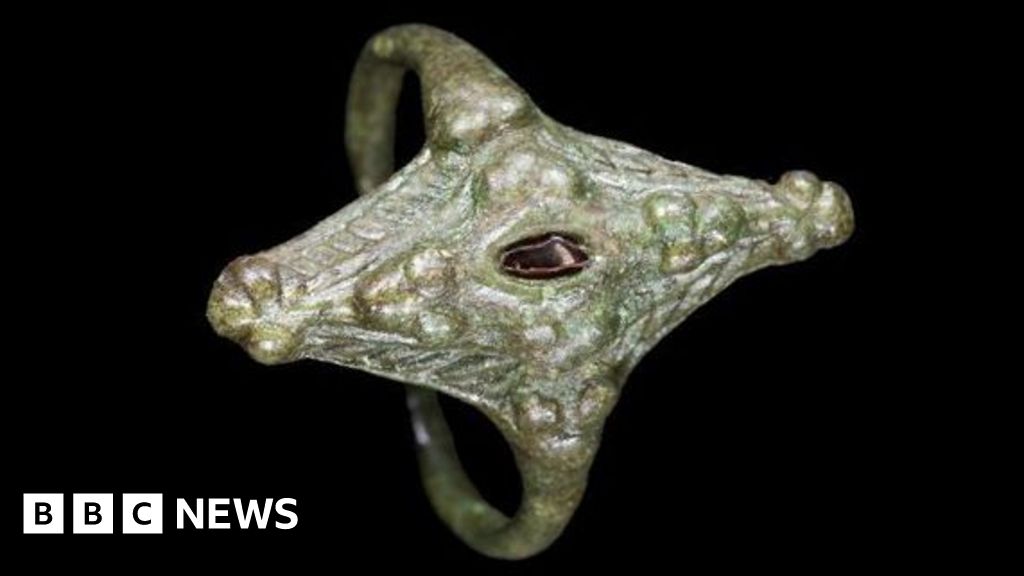 www.bbc.com
www.bbc.com
> A "remarkable" Pictish ring thought to be at least 1,000 years old has been discovered by a volunteer on a dig in Moray. > >The find was made by John Ralph at the site of a fort in Burghead. > >It is thought the settlement was a significant seat of power within the Pictish kingdom between AD500 and AD1000. > >Delighted Mr Ralph - who described himself as an "enthusiastic volunteer" - was on a dig being led by the University of Aberdeen. He felt like a "striker scoring a goal" with the find.
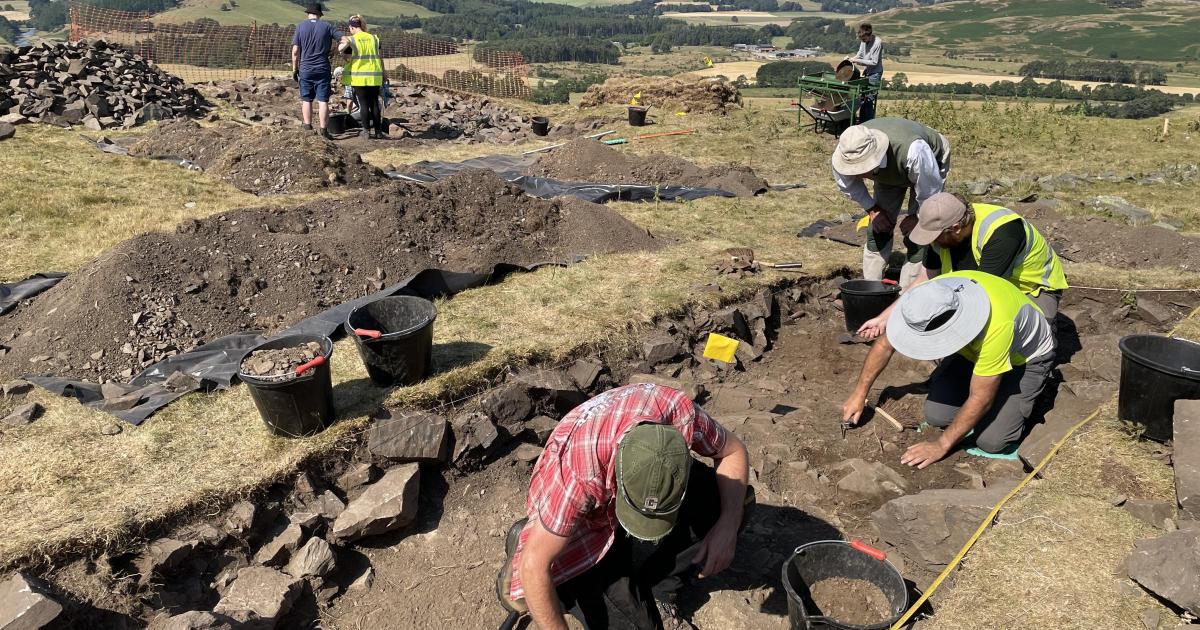 www.thenational.scot
www.thenational.scot
> The village of Drumelzier in the Borders has long been associated with Merlin. > >According to Vita Merlini Sylvestris (the Life of Merlin of the Forest) — a medieval manuscript held by the British Library — Merlin was reportedly imprisoned there and buried on the banks of the Tweed in the 7th century. > >In 2022, a team of volunteers drawn from across Scotland and led by GUARD Archaeology set out to investigate the archaeological roots of this local legend. > >Now, the results of the work have been published with experts revealing that there may indeed be some truth to the reports of Merlin's death in Scotland. > > A geophysics survey revealed that there is an archaeological feature resembling a grave near to the reputed location of Merlin’s Grave at Drumelzier. > >An excavation of Tinnis Fort, which overlooks Merlin’s Grave, also found that this prominent hillfort was occupied around the late 6th and early 7th centuries AD, precisely when the story was set. > >Archaeologists said the fort has the hallmarks of a lordly stronghold of the time. > > "The Drumelzier legend contains pre-Christian customs, ancient Cumbric names and was associated with local sites where archaeology now shows could credibly have given rise to the story," said GUARD Archaeology CEO Ronan Toolis, who led the project. > > ... > > "Unlike the classic depiction of Merlin as the wise and respected adviser to King Arthur, the Drumelzier legend paints a much darker picture. > >"That of a rather pitiful fellow prone to uttering nonsensical riddles and bewildering prophecies, and kept prisoner by an obscure petty tyrant of a forgotten kingdom, before dying a gruesome death, the victim of royal intrigue." [Archive](https://archive.is/RShoo)
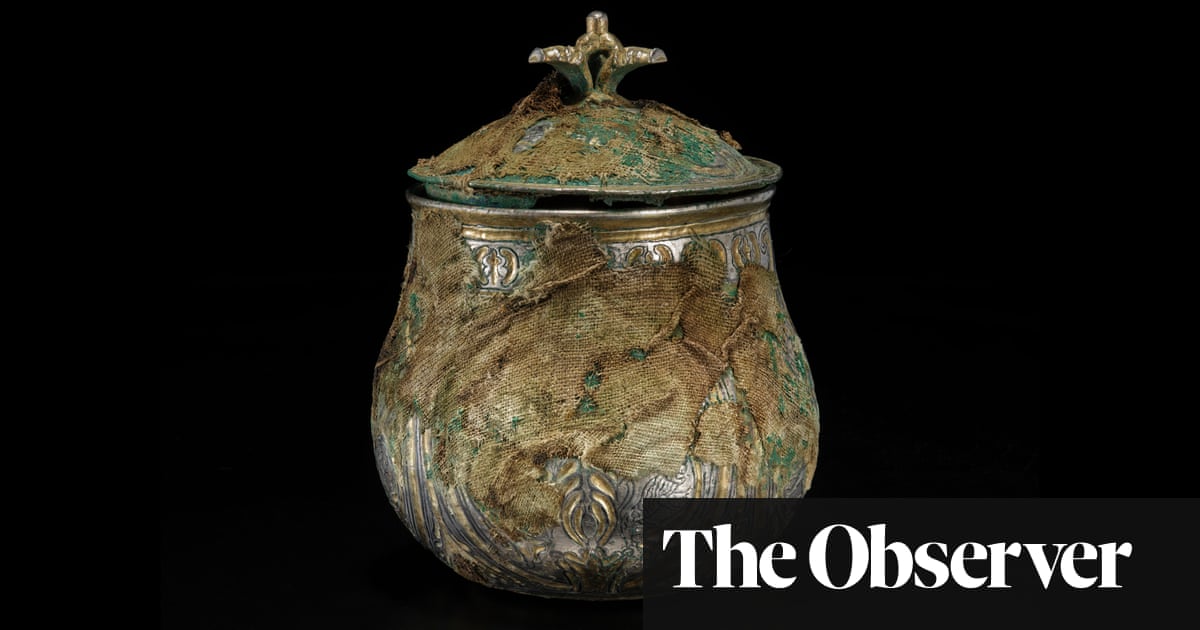 www.theguardian.com
www.theguardian.com
> It is a star object of the Galloway Hoard, the richest collection of Viking-age objects ever found in Britain or Ireland, buried in AD900 and unearthed in a field in Scotland. Now a lidded silver vessel has been identified as being of west Asian origin, transported halfway around the world more than 1,000 years ago. > > When it emerged from the ground a decade ago, the vessel was still wrapped in its ancient textiles, whose survival is extremely rare. Its surface could be seen only through X-ray scans. Since then, the textiles have been partially removed and preserved and the vessel has had laser cleaning to remove green corrosion over much of its silver surface. It has also undergone scientific analysis. > >Details of a “remarkable” design that includes crowns, fire altars and creatures including leopards and tigers can be seen for the first time. > >The imagery is linked to the iconography of Zoroastrianism, the state religion of the Sasanian empire, the last Persian empire before the early Muslim conquests from AD632. Scientific analysis shows that the silver from which it was made came from a mine in modern-day Iran. > > The hoard was discovered in 2014 by a metal-detecting enthusiast on what is now Church of Scotland land at Balmaghie, Kirkcudbrightshire. Described as one of the century’s most important UK archaeological finds, it contained more than 5kg of silver, gold and other materials, with objects ranging from a Christian pectoral cross to brooches.
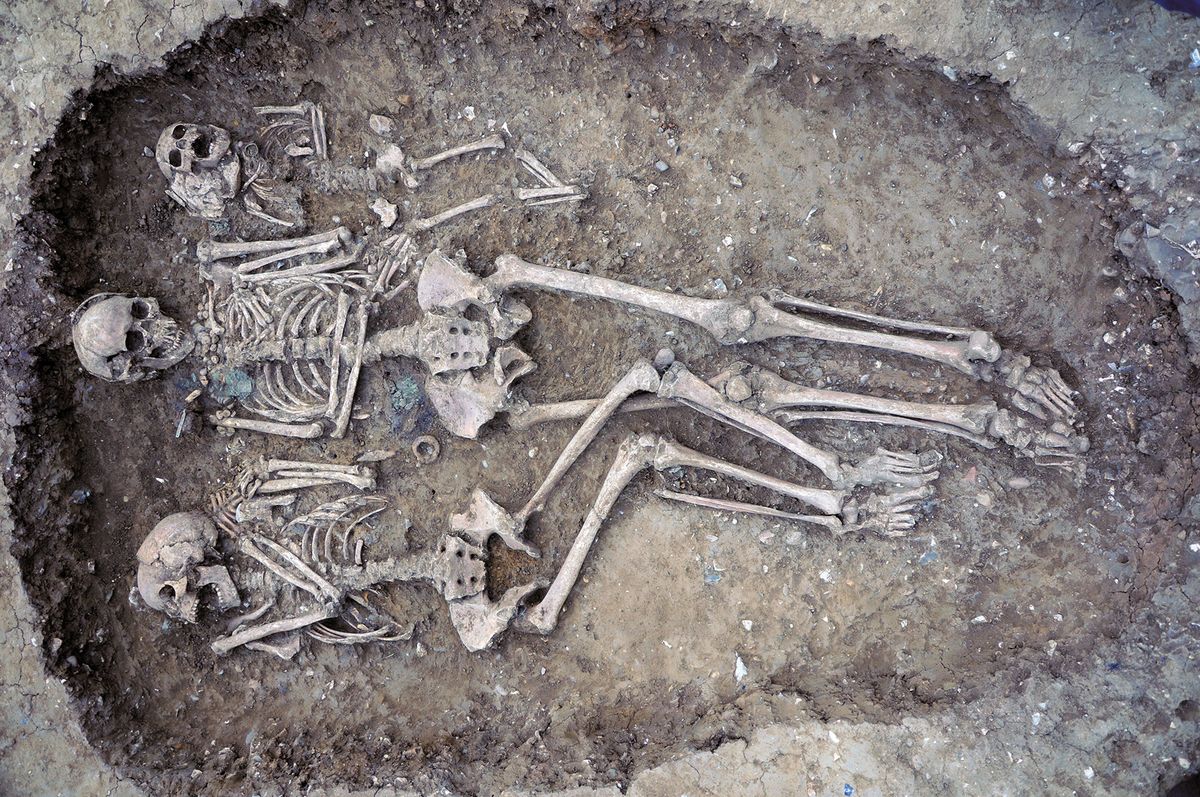 www.smithsonianmag.com
www.smithsonianmag.com
> Since the Renaissance, scholars have been engaged in a curious and feverish debate over where the people who populate England came from. Did they arrive as conquerors, as Gildas would have it? Or by a more gradual and peaceful migration? The answer matters because it provides an explanation for a perplexing reality: In a remarkably short three centuries after the Roman occupation, Britain was transformed into a dramatically different kind of place. > >Under Roman administration, Britain was largely urban. People lived in tile-roofed stone buildings in towns connected by roads; they boasted a standing army and a coinage system. Native Britons spoke an indigenous Celtic language and probably some Latin. By the 700s, things had changed entirely: Inhabitants lived mostly in country hamlets in wood-and-thatch homes resembling Grubenhäuser, those partly sunken houses typical of northern Germany and southwest Denmark. With the empire gone, many workers, from builders to vintners to smiths to perfumers, simply no longer had a market for their products or services, so the only way to survive was subsistence farming. In this way, the Britons produced what they needed, and they bartered for the rest. The things they made, jewelry or pots, drew on both continental and indigenous traditions but were uniquely theirs. Most striking, they had created a new national identity and were speaking a new language, the earliest form of English. > > But exactly how was the Roman Britain of 400 transfigured into the radically different country we now call England—all in less than 300 years? Recent scholarship presents an intriguing, and persuasive, case for the migration hypothesis. Analyzing DNA from hundreds of Anglo-Saxon-era bones in England and in northwest Europe, a paper in the journal Nature has concluded that as much as 76 percent of ancestry in eastern medieval England came from what is now Germany and Scandinavia. Meanwhile, archaeologists continue to uncover artifacts in Anglo-Saxon cemeteries that arguably weigh heavily against the theory of origin-by-conquest; indeed, no graves suggesting wealth have been linked to any purely Germanic settlers. The findings suggest something rather remarkable: that some of the most precipitous shifts in social and material culture can come not from war but from peace. > > ... > > If there had been a conquest and a resulting upper class of Germanic warriors, you’d expect to see two distinct genetic pools. Not so. “This paper is paradigm-shifting,” says Oxford archaeologist Helena Hamerow, who reviewed the group’s work for Nature. “Clearly the native Britons were not nearly exterminated and/or driven out,” she adds, “but many must have intermarried with and lived amongst immigrants and their descendants.”
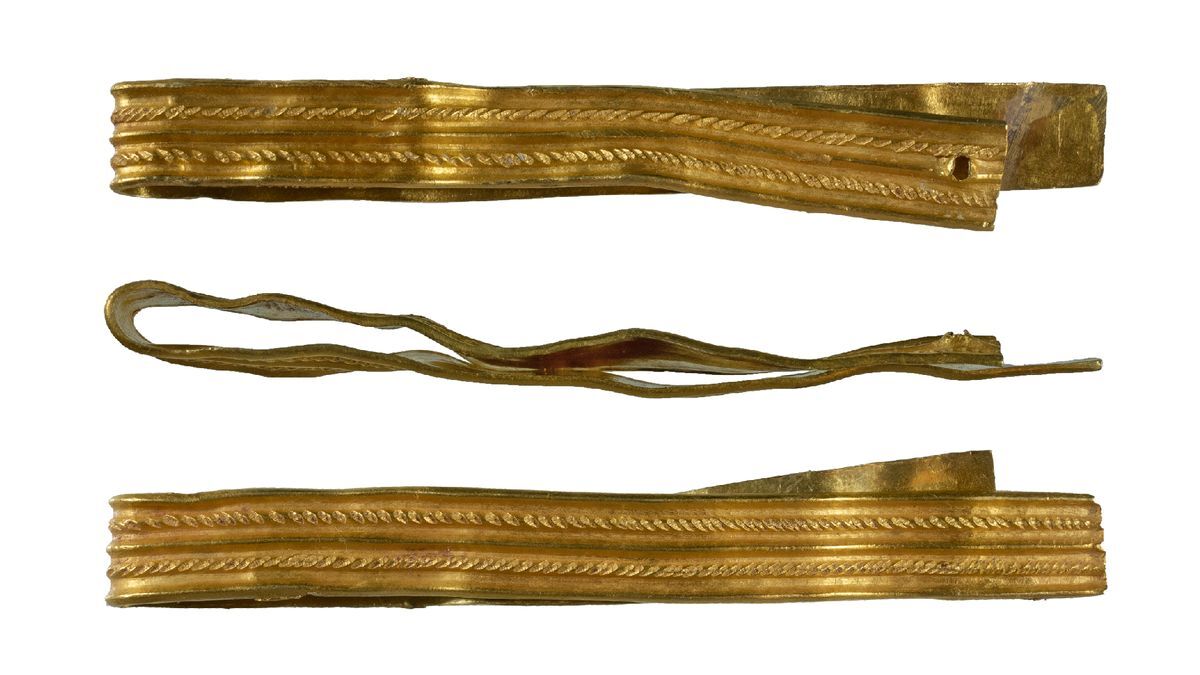 www.livescience.com
www.livescience.com
> While walking his dog with his mom, a 12-year-old boy in the U.K. made an unexpected discovery in a field — not a stick for his dog or an interesting rock, but a first-century gold bracelet from Roman Britain. > > Unlike most other jewelry from the Roman era, the lustrous bracelet probably wasn't worn by a woman, researchers later surmised. Instead, it likely belonged to a man who had received the accessory as a military honor, likely an "award for bravery," according to a statement from the local Chichester District Council. > >The cuff bracelet has been described as "exceptional" and "relatively rare in Roman Britain," especially because it's crafted from gold, according to the statement. > > ... > > A newly announced analysis of the bracelet revealed that it was made from sheet gold with raised moldings, and it dates to the first century A.D., not too long after Roman emperor Claudius invaded Britain in A.D. 43.
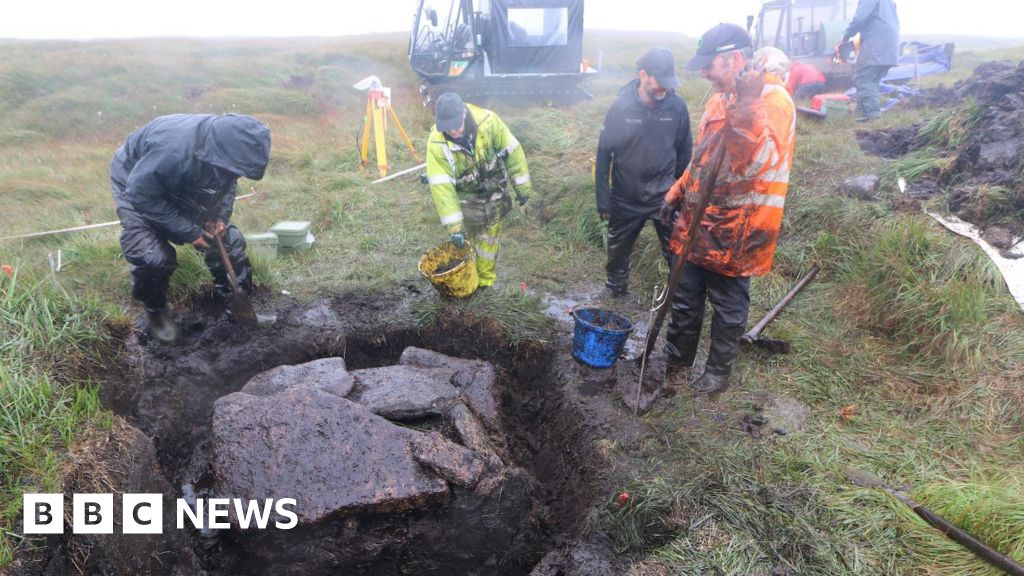 www.bbc.co.uk
www.bbc.co.uk
"Archaeologists have unearthed a "stunning" Bronze Age burial chamber on one of Dartmoor’s most isolated hills. Experts discovered a stone-built box, sometimes known as a cist, at Cut Hill during a three-day dig earlier this month. Radiocarbon dating of charcoal found inside suggests the chamber, used to bury the dead during prehistoric times, is about 3,900 years old. Dartmoor National Park Authority (DNPA), which led the project, said the discovery had been prompted by reports of a feature being visible in the peat..."
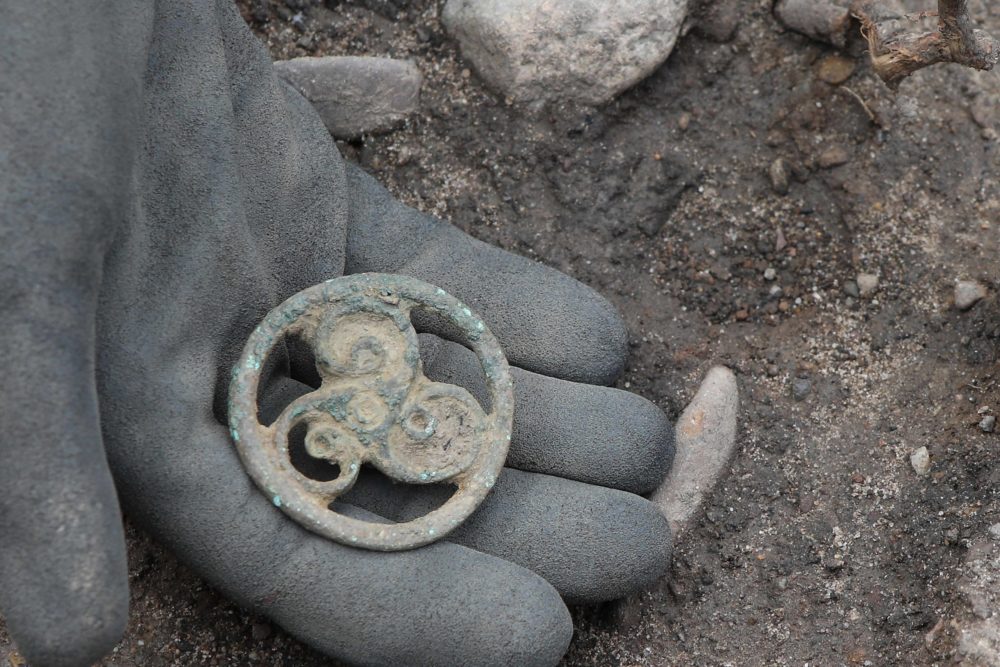 nation.cymru
nation.cymru
> A piece of the jigsaw puzzle that could unlock 1,000 years of history at a north Wales heritage site has been unearthed – suggesting that local Britons may have lived ‘in harmony’ with the Romans. > >An excavation has led to the discovery of a horse bridle mount dating back to the late Iron Age at the Greenfield Valley Heritage Park in Flintshire. > >The artefact, which is up to 2,000 years old, was found within the remains of a newly discovered settlement that likely belonged to the Iron Age Deceangli tribe but appears to have continued into the early Roman period. > >The region occupied by the Celtic clan, which spread as far west as the River Conwy and included Denbighshire, Flintshire, and Wrexham, was rich in lead and silver, materials highly prised by the Romans.
> Archaeologists have uncovered a 2,000-year-old prehistoric settlement as part of development work on the site of the new HMP Highland in Inverness. > >The excavation has led to the discovery of a roundhouse settlement relating to Iron Age and Bronze Age occupation of the site, which also contained earlier prehistoric remains dating back to at least 3,000 BC. > >A wide variety of prehistoric remains were found at the HMP Highland site, including occupation areas related to domestic and industrial activities and structural evidence from the roundhouses and other timber structures. > > The settlement consisted of 16 roundhouses that survived as circular alignments of postholes, where timber posts had once supported substantial hut buildings. Some of the house sites had been enclosed by palisade fencing to protect the interior.
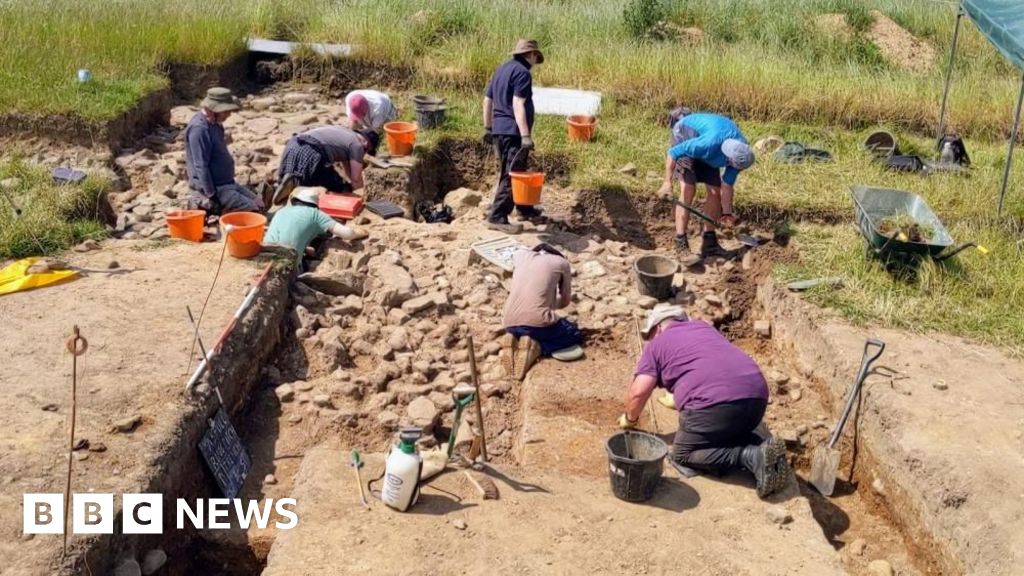 www.bbc.com
www.bbc.com
> An ancient monument uncovered by a team of amateur archaeologists is exciting and puzzling the experts. > >Three years of excavations on the side of a hill in Aspull, Wigan have revealed a Bronze Age burial site surrounded by a ring shaped ditch that is believed to be a religious henge. > >The find is thought to be unique to the region and potentially of national importance. > > ... > >The archaeologists working at the site believe it marks two different points in history. > >"From the Neolithic Stone Age period it would have been a ritual holy site," Mr Aldridge said. > >"But then at a later date, when the Bronze Age people came along, they thought it was something special and decided to create their own funerary monument in the middle of it. > >"You do get Bronze Age barrows in the north, but they’re quite rare. You usually find them down south in places like Wiltshire. > >"And you have to go to the Lake District, Yorkshire, Derbyshire or North Wales before you get henge monuments or Neolithic Stone Age activity.
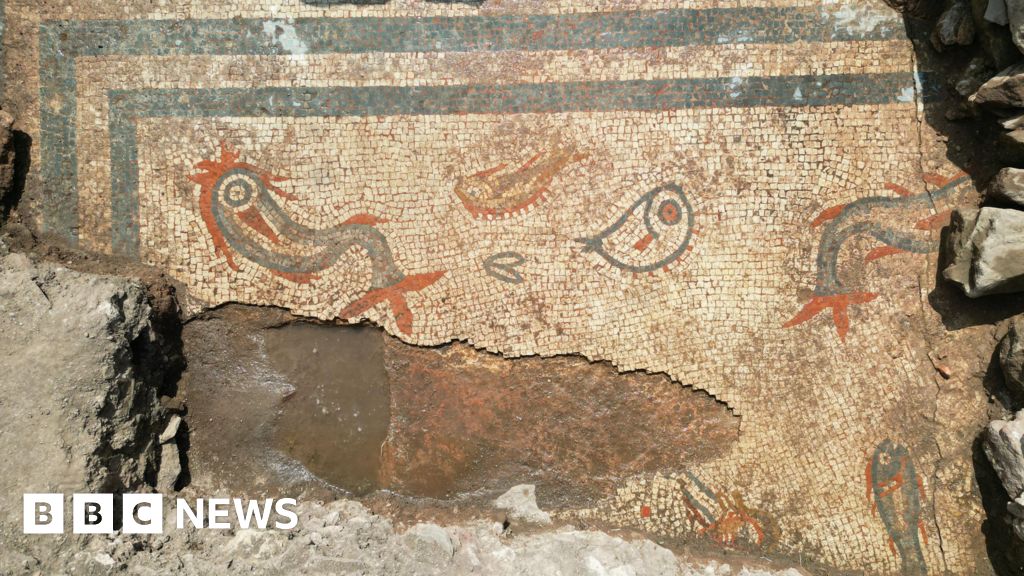 www.bbc.com
www.bbc.com
> A 2,000-year-old mosaic has been discovered during excavations at a Roman site in Shropshire. > >The piece at Wroxeter Roman City depicts brightly-coloured dolphins and fish. > >It was uncovered during work to search for the main civic temple. > >"Our excavations were in hope of discovering the walls of this building, but we never suspected we would find a beautiful and intact mosaic, which had lain hidden for thousands of years," said Win Scutt, from English Heritage.
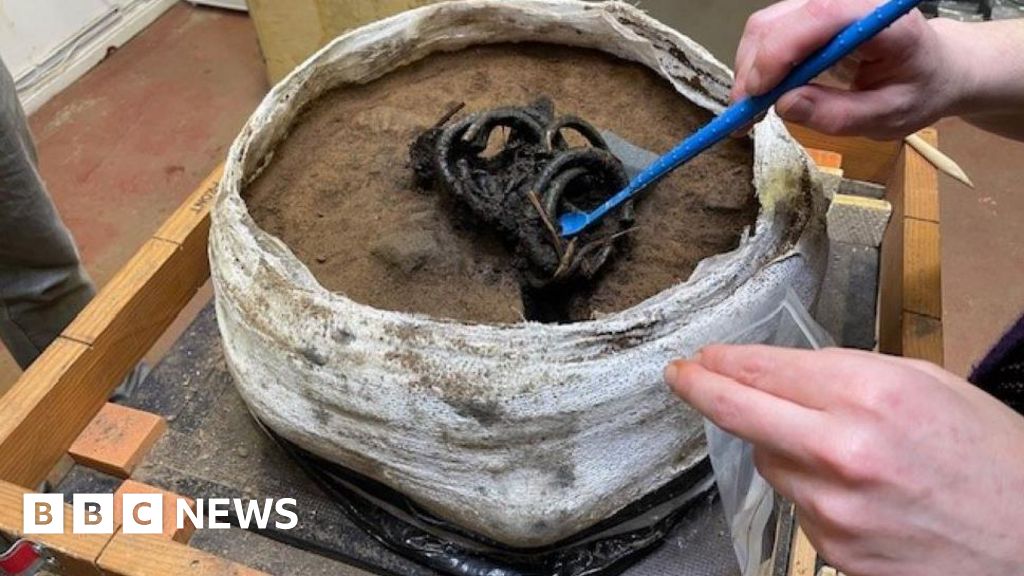 www.bbc.com
www.bbc.com
> Rare remains of plants have been found on Bronze Age jewellery uncovered in the Highlands. > >Archaeologists said the fibrous cords used to knot together bracelets had survived for about 3,000 years. > >The ancient hoard, which appears to have been carefully buried, was found at a building site in Rosemarkie on the Black Isle where a Bronze Age village once stood. > >It contained nine bronze bracelets and necklaces buried sometime around 1000 BC. > > ... > > Rachel Buckley, who led the work, said: "While there are other examples of hoards where it has been postulated that items were bound together due to their positioning, the vegetation in the Rosemarkie hoard has survived for approximately 3,000 years, proving that these artefacts were held together." > >Archaeologists said the finds would help to improve knowledge of the lives, beliefs and deaths of Bronze Age people in the Highlands.
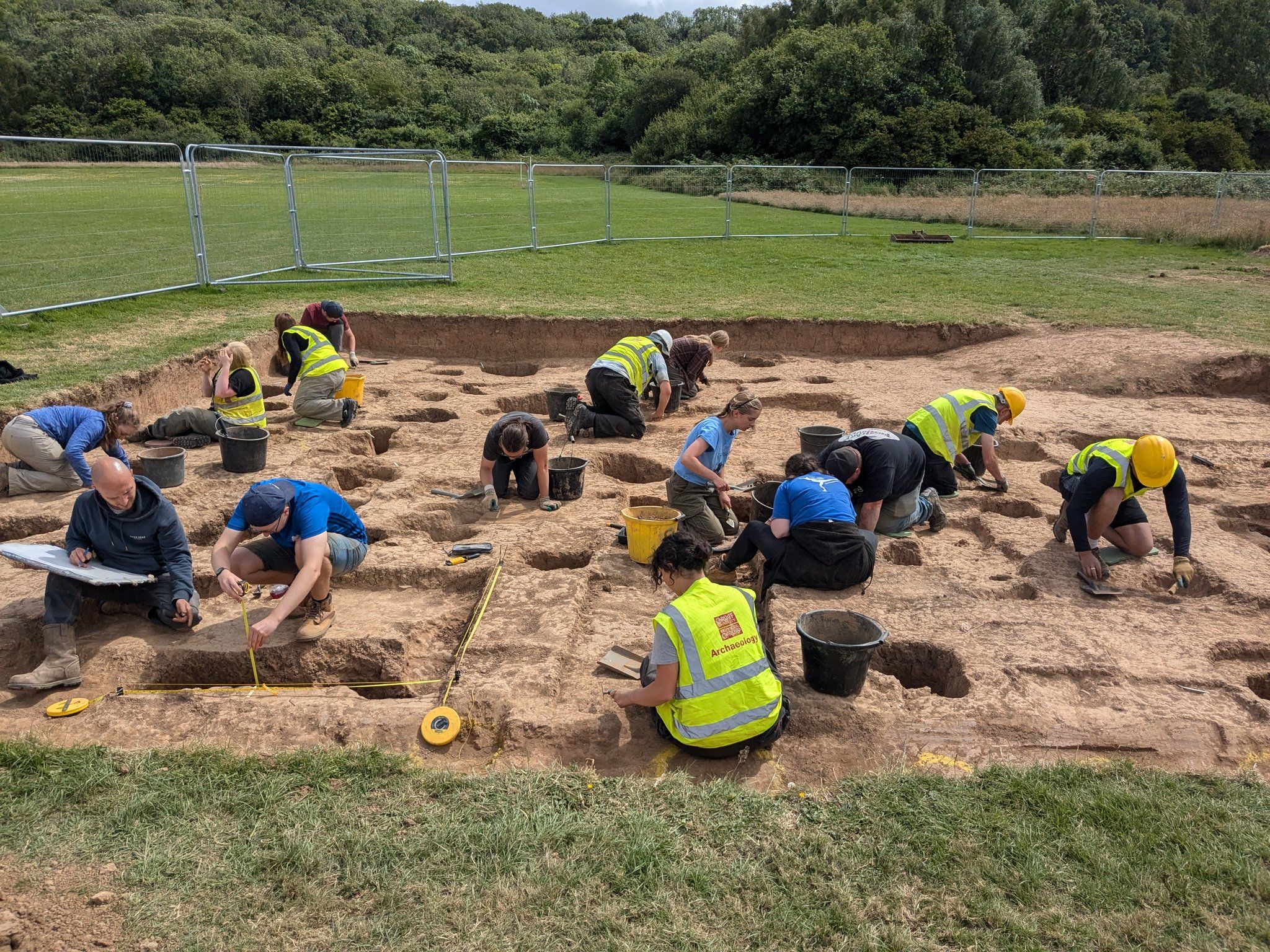 news.artnet.com
news.artnet.com
>A large open space in in Trelai Park that had been used as a playing field since 1933 yielded a treasure trove of prehistoric artifacts during a 2022 land survey conducted by a local school that was building a sports field in a corner of the park. Upon the archaeological site’s discovery, the Caerau and Ely Rediscovering Heritage Project (CAER), an organization promoting community involvement in archaeological research, began collaborations with Cardiff University to excavate the area. > > Archaeologists initially expected the discovery would shed new light on everyday life in the region between the late Iron Age and early Roman Era. To their surprise, unearthed shards from a clay pot dated the site to the Bronze Age, around 1500 B.C.E. > > The excavation was soon found to constitute two Bronze Age roundhouses—circular dwellings, typically featuring thatched roofs, that were made up of walls built using wooden or stone posts and stuffed with wattle-and-daub, a mixture of twigs, earth, and clay. The roundhouses have been dubbed the oldest houses in Cardiff.
 www.cbsnews.com
www.cbsnews.com
> Metal detectors beeped across a quiet, five-acre plot of forest and field on England's eastern Suffolk coast as dozens of American and British service members sifted clumpy, wet soil from a deep impact crater. The tiniest of remains of U.S. Air Force pilot Lt. John Fisher might be here. Exactly 80 years ago Sunday - August 4, 1944 - his B-17 bomber crashed while on a secret mission targeting Nazi rocket sites in Europe during World War II. > > "It can make you feel emotional, you know? They've found some personal artifacts that are very endearing," said Garret Browning, a U.S. air repair specialist from Colorado with the U.S. 100th Maintenance Squadron, currently stationed in England. > > Experienced in crash damage recovery, Browning is one of about 150 American and British active duty and retired military volunteers looking for a fallen fellow soldier. At 26 years old, Browning is already older than the pilot he was looking for. > > ... > > Lt. John W. Fisher Jr., from New York, was just 21 years old when he was killed during Operation Aphrodite, the codename for flying planes on one-way missions to destroy Nazi rocket sites and submarine pens in Europe. Those planes were old, war-weary B-17 "Flying Fortress" bombers, first stripped down for more space, then loaded up with tons of explosives. But Fisher's plane stalled soon after takeoff. He pushed his co-pilot out and sacrificed himself. The plane nosedived into the ground just before the English Channel with France on the horizon. > >"This aircraft, it blew apart pretty much in every direction," said Browning. "So something as small as just a bolt or a thread just kind of tells a story." > >The remnants these volunteers have found include shattered bits of glass from an oxygen bottle - which might suggest Fisher's remains are nearby. The biggest and heaviest piece of debris was the central part of a propeller with much of its blades sheared off. Other pieces were fragments of the fuselage, engine and even some fabric from a parachute. > >Volunteers also found a rusted horseshoe, believed to have been taken on board Fisher's B-17 for luck, and a twisted, fire-darkened nameplate reminding excavators of the origin of the plane from across the Atlantic Ocean: Detroit, General Motors Corporation.
 www.theguardian.com
www.theguardian.com
> A previously unknown Roman fort discovered in Pembrokeshire in Wales overturns assumptions that the area’s indigenous Celtic tribe was on peaceful terms with the Roman invaders. > >The site, which has excited archaeologists, had been hidden until now beneath an enormous, overgrown field. It explains why the land had been unsuccessful for farming: the farmer kept hitting stone. > > The discovery was made by Dr Mark Merrony, a leading Roman specialist and tutor at Oxford University, who said: “It is a humongous fort, an incredible find of national importance.” > >He is all the more excited because it is right next to a Roman road that he has also identified for the first time. > >The fort is thought to date from the first to the third centuries, when the Celtic Demetae tribe inhabited the south-west area of modern Wales. > >They were thought to have been pro-Roman, meaning there was less need for a major military presence to quell local resistance. > >Merrony said that this fort suggested this part of Wales was considerably more militarised than previously thought: “I now don’t think they were pro-Roman at all, but that the Romans were hitting the area with an iron fist.” > >He noted that its form and scale was like the only other Roman fort known in Pembrokeshire, excavated at Wiston near Haverfordwest in 2013. Both forts were now linked to a Roman road network that had not previously been known, he said.
> The recent discovery of more than 600 red ochre fragments at a 6,500-year-old ceremonial site near Carlisle, northwestern England, supports an ancient Greek explorer’s account from the 4th century BC in which Britons are referred to as “the painted people.” > >Pytheas of Massalia, an explorer from the Greek colony that is modern-day Marseille in southern France, was quoted by later geographers to have spoken of Great Britain as Prettanike, a term derived from the Celtic word Pretani, meaning “the [land of the] painted ones” or “the tattooed folk.” > >Julius Caesar, writing in the mid-1st century BC, also mentioned that the inhabitants of Britain had a tradition of painting themselves. > > The Carlisle red ochre discovery—the largest find of red ochre pieces found yet in the UK—not only complements the linguistic evidence on ancient Britons’ tradition of body painting but also suggests a long-held gathering or festival which featured body painting rituals, according to The Indepenent. > >A number of stones that would have been used to grind ochre deposits into powder were also found along hundreds of thousands of fragments of flint. > > Additional findings support the idea that the people that gathered at the Stone Age site in Carlisle, most probably during the salmon-fishing season in spring, originated from across Britain. > > ... > > Pytheas of Massalia was the first-ever Mediterranean to reach and explore Great Britain and the Arctic Circle. > >He is believed to have traveled as far as Iceland, becoming the first person on record to describe the midnight sun and the first known scientific visitor to see and describe the Celtic and Germanic tribes.
> For the past few weeks, the site of redevelopment work at 32 Stodman Street has been host to an archaeological dig by a specialist team from Contour Archaeology Ltd to ensure nothing is missed before building work commences. > >The team have explored the history of the town dating back to the medieval period, to develop an understanding of the historical events that occurred on the site, and its place within the history of the town. > > Archaeology work has identified Medieval features including walls, wells, enclosure boundaries and pits, one of which contained the fully intact horse burial. > >Other finds across the site include roof tiles, pottery, metalwork, and animal bones, such as boar’s tusks as well as cow and sheep bones, which indicate the type of diet medieval people of Newark would have eaten. > > Other smaller items are thought to date back as far as the Anglo-Saxon period — with further investigation into this period set to take place.
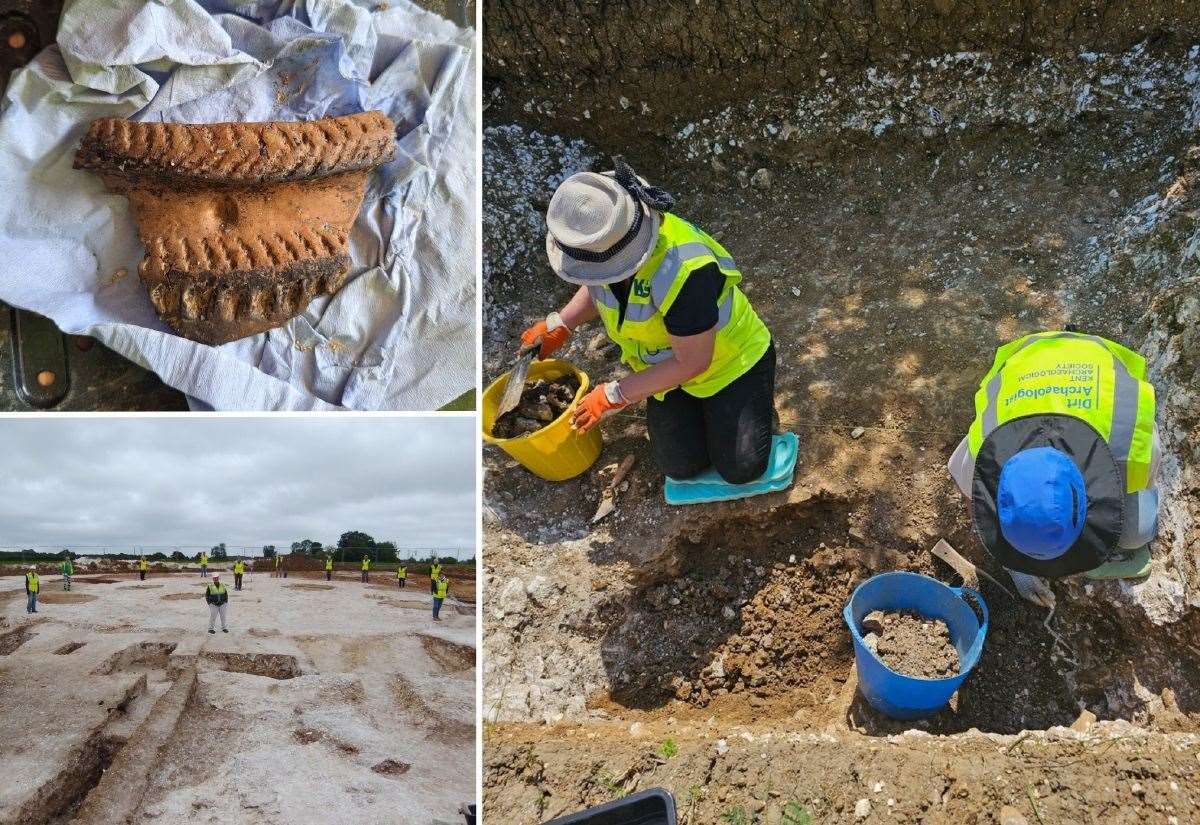 www.kentonline.co.uk
www.kentonline.co.uk
> Archaeologists are finding out more about prehistoric life in Kent from 5,000 years ago at one of the country’s largest ancient burial grounds. > >Experts say the multi-year dig at Stringmans Farm on the Lees Court Estate, near Faversham, has uncovered artefacts dating back to the Neolithic or Bronze Age period. > > The community excavation project led by a team from the Kent Archaeological Society unearthed a selection of items including flint chippings (leftovers from making stone tools), fragments of rare, decorated pottery created 3,000 years before the Romans came to Kent, and evidence of human prehistoric cremations.
> Wigan Archaeological Society members have been unearthing ancient treasures and revealing a previously unknown monument thought to date back to 1650 BC on open land at Aspull. > >The enigmatic site first came to their attention in 2019, when a near-circular cropmark was spotted in overhead images seen online. > > At first it was thought it might represent the remains of a barrow (burial mound) but investigations were hampered for a long time by the pandemic. > > The site – which the archaeologists first called Aspull Ring Feature – lies within sight of Winter Hill and Anglezarke Moor, areas rich in prehistoric monuments and it was thought they might be connected. > > There then followed the digging of a series of exploratory trenches, the first of which concluded that the area had been a ditch was deliberately filled in so they changed its name to Aspull Ring Ditch. > >Further trenches established the shape of the ditch and uncovered a carefully built structure of alternating layers of sand, rounded stones, and clay. Helpfully, at least two long pieces of burnt wood were also involved in its make-up, allowing experts to take samples for radiocarbon dating which gave them a date from the middle Bronze Age: 1650 BC. > > By the close of the 2022 season, they had working theory that the feature had originated as a Neolithic henge monument, which was then repurposed during the Bronze Age, possibly as a funerary enclosure (mortuary). > > ... > > A spokesperson for the society said: “While there are still many puzzles and conundrums to unravel at this site, there are two finds that so far defy explanation. > > "The first is an irregular stone ball covered with brown and white patinas that hinder identification of the rock type, but it might be granitic, and is certainly not local. > >“Our second enigma is a stone inscribed with three deep, parallel grooves, 9mm apart. Then another one turned up, this time with four parallel grooves spaced 8.4mm apart. Better still, it was found in a carefully excavated section, meaning that we can tell it was definitely beneath the burnt layer dated to 1820 BC. Like buses, a third example duly appeared, again in a certain prehistoric context and this time with eight grooves 10mm apart. > >“In each case, the grooves are precise and deep, unlike, for example, sharpening stones, where the grooves tend to be at random angles and anything but precise. What they mean, though, is truly mystifying.
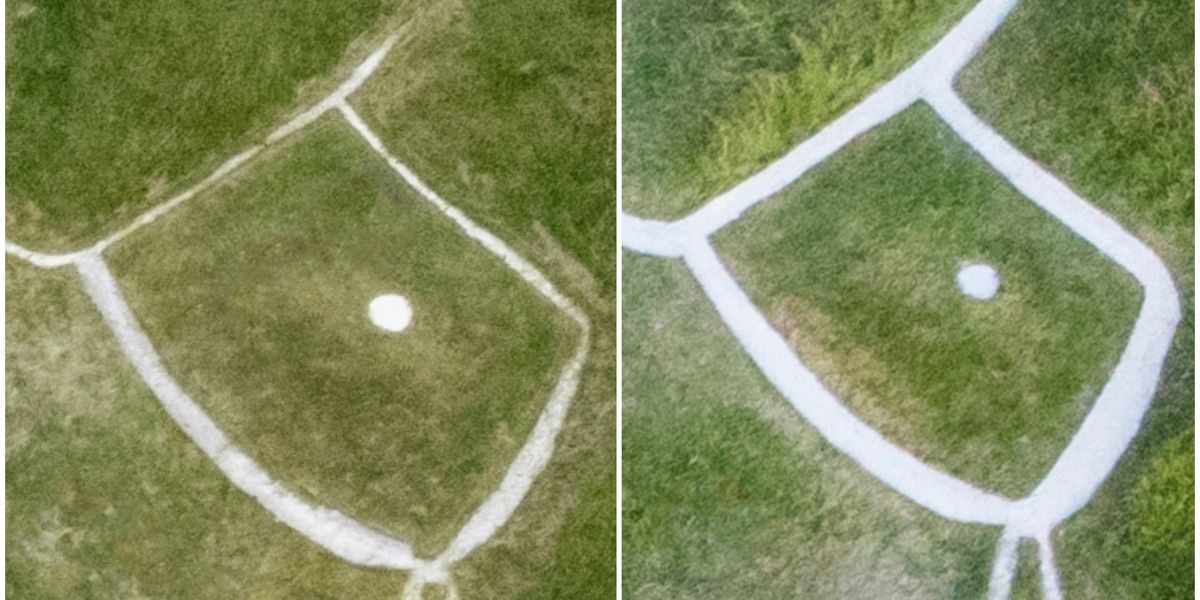 www.indy100.com
www.indy100.com
> Archaeologists have given Britain’s oldest chalk figure a facelift, with work to restore the head and neck profile of the Uffington White Horse in Oxfordshire. > >Archaeological work last year, including examination of previous surveys, showed that parts of the ancient chalk horse carved into the hillside have narrowed over time, as grass has encroached and topsoil slipped. > >The head and neck area of the 3,000-year-old figure had narrowed to less than half its typical width. > > Now archaeologists from the National Trust and Oxford Archaeology have returned the 364ft (111m) long horse, which dates from the Bronze Age, to its typical profile, by carefully cutting the encroaching turf back to the estimated original edge and re-distributing some of the top layer of chalk on the figure. > >During the work, soil samples from the lowest layers of the figure have also been taken to see if they can be used to accurately date its creation. > > Previous samples taken in the 1990s revealed the horse to be Britain’s oldest chalk figure, but techniques to date archaeological remains have improved so there is an opportunity to refine the date further, the team said.
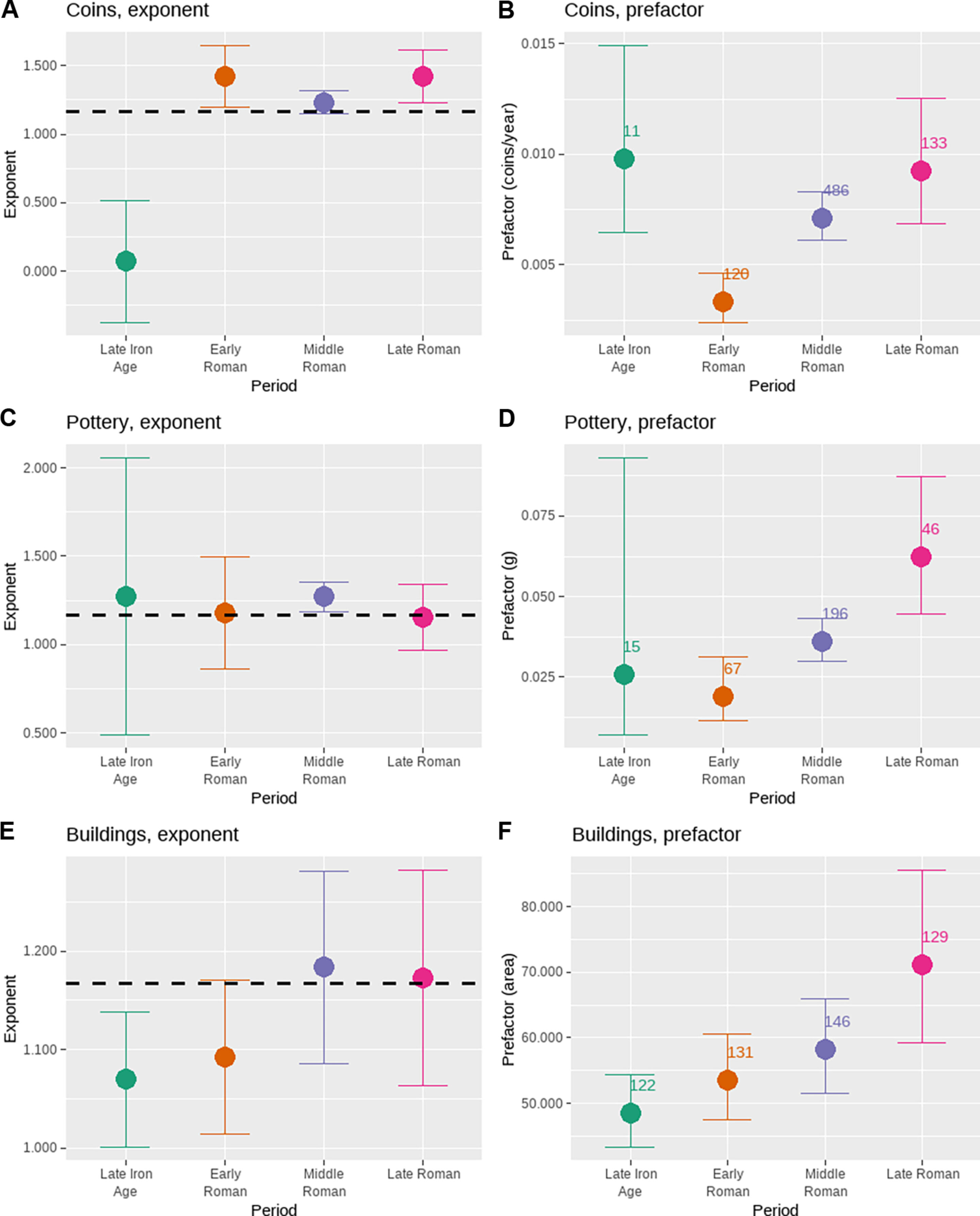 phys.org
phys.org
> In their study, published in the journal Science Advances, the group studied three types of archaeological evidence collected from multiple sites across the U.K. to measure economic growth. > > Over the past several decades, the U.K. has enacted laws requiring archaeological investigations on land under development. These studies have led to a large number of archaeological finds. For this new study, the researchers used data from such finds to measure the economic impact of Roman conquest and occupation over hundreds of years approximately 2,000 years ago. > > To gain insight into how Roman rule may have impacted Britain, the research team looked at three types of artifacts: buildings, coins and pottery. More specifically, they looked at how such artifacts changed in the years after the Roman conquest. Houses got bigger, they noted, and as people grew richer, they became more careless with their coins, resulting in more of them being lost between floorboard cracks. > > As living standards improved, so did the quality and diversity of pottery used for preparing and eating meals. In making such comparisons, the research team was able to watch how economic growth impacted the people who had been conquered. > > They found that in many cases, it had been what they describe as intensive—it greatly exceeded the type of growth that would have been expected for the region if the Romans had not arrived with their advanced technology and rules of business conduct. > > In their study, published in the journal Science Advances, the group studied three types of archaeological evidence collected from multiple sites across the U.K. to measure economic growth. > > Over the past several decades, the U.K. has enacted laws requiring archaeological investigations on land under development. These studies have led to a large number of archaeological finds. For this new study, the researchers used data from such finds to measure the economic impact of Roman conquest and occupation over hundreds of years approximately 2,000 years ago. > > To gain insight into how Roman rule may have impacted Britain, the research team looked at three types of artifacts: buildings, coins and pottery. More specifically, they looked at how such artifacts changed in the years after the Roman conquest. Houses got bigger, they noted, and as people grew richer, they became more careless with their coins, resulting in more of them being lost between floorboard cracks. > > As living standards improved, so did the quality and diversity of pottery used for preparing and eating meals. In making such comparisons, the research team was able to watch how economic growth impacted the people who had been conquered. > > They found that in many cases, it had been what they describe as intensive—it greatly exceeded the type of growth that would have been expected for the region if the Romans had not arrived with their advanced technology and rules of business conduct.
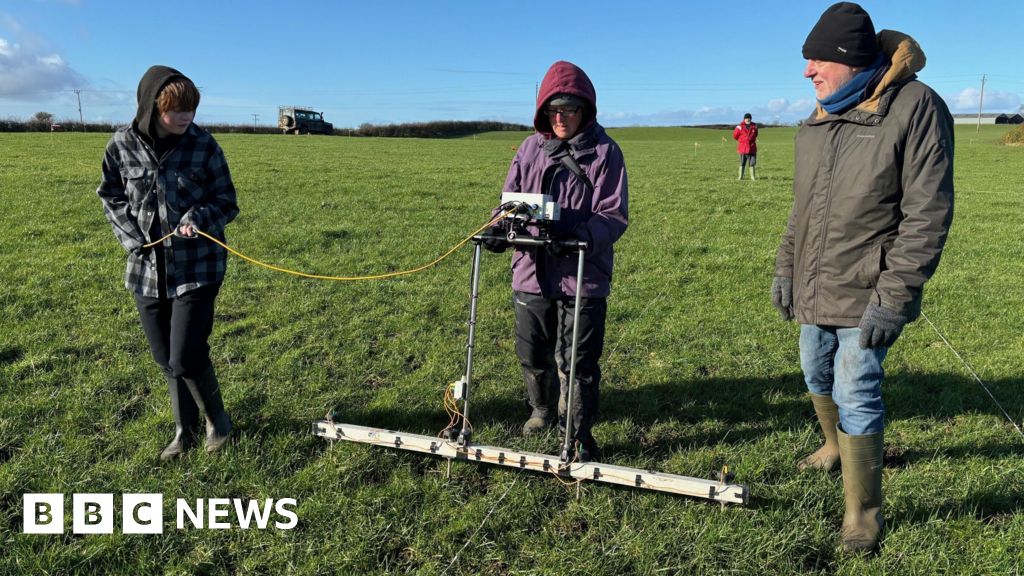 www.bbc.com
www.bbc.com
> Volunteers are set to take part in a 12-day archaeological dig in the hope of finding signs of medieval life on a farm. > > The excavation at High Tarns Farm in Silloth will begin on 22 July. > > It will be led by archaeologist Mark Graham and follows his discovery of crop marks on the land, which suggest it was once the site of a large medieval building. > > Mr Graham said he was "excited" but warned it could be a let down, adding: "If you're going to be an archaeologist, you better get used to disappointment." > > Due to written records, archaeologists have long known that part of the town was once the site of a medieval farm linked to Cistercian monks. > > ... > > The marks looked like a "footprint of a large timber building", he said, adding: "I nearly fell off my chair." > > He suspected the building was timber as the marks corresponded with holes required for large wooden posts to hold up such a structure. > > No such building is detailed in maps going back to the 1800s, he added, and the marks suggest the building is about 50m (164ft) long and 20m (66ft) wide. > > Mr Graham's two main theories about the potential building are that it was once a barn belonging to the Cistercian farm, or it is even older and was the home of a Viking chieftain. > > "There have been houses on the scale that we're talking about excavated in Scandinavia but to find such a thing here in Cumbria would be absolutely remarkable," he said.
> In an extract from her new book, A Mudlarking Year: Finding Treasure in Every Season, Lara Maiklem describes the thrill of discovering a 16th century sword on a Bankside beach. > > *Thursday 2 February 2022* > > I hear from the Museum of London today about the 'sixteenth-century bladed object' I found last year. My Excalibur moment happened at the beginning of December on a murky Saturday afternoon. I don't usually mudlark on the weekend — the foreshore is often busier and I try to keep weekends for family time — but I was in London meeting friends for lunch that day, and as I made my way back to the station, I saw the tide was low. Actually, I knew the tide was low, which is why I took the longer route along the river to the station. How could I not? I only briefly considered my new brogues, which were entirely unsuitable, before unlatching the metal gate and taking the concrete stairs down onto the foreshore at Bankside. The light was fading, and I knew I didn't have long before I lost it altogether, so I headed straight for my favourite patch. People were already there, and I could see from the footprints that it had been well searched, so I walked a little further along and that's when I saw it. > > ... > > The handle and hilt loomed out at me from a small area of gritty sand that thinly covered the mud into which the blade disappeared. What caught my eye was its regular shape and the two lines of twisted gold wire embedded in the dark brown material of the handle. The blade was only just beneath the surface, and I gently cleared away the sand until I felt the end of it with my fingers. Easing my hand carefully underneath, I lifted it free quite easily, leaving a perfect impression of where it had lain for the best part of 500 years in the dark grey mud. I held the sword aloft. Excalibur of the Thames! And looked around, but everyone had gone and there was nobody to share the moment with. The handle looked to be made of wood with a square pommel carved into the end, finished off by a four-petalled flower or quatrefoil in what I assumed was copper alloy. The blade was broken at about eight inches long and was encrusted in a thick layer of mud, pebbles and rust. When iron rusts, it often engulfs whatever is lying next to it in the mud and ends up looking like a giant caddisfly larva case. If it had been a Victorian padlock or an old horseshoe, I would have been tempted to knock the concretion off with a stone, but this was too precious.
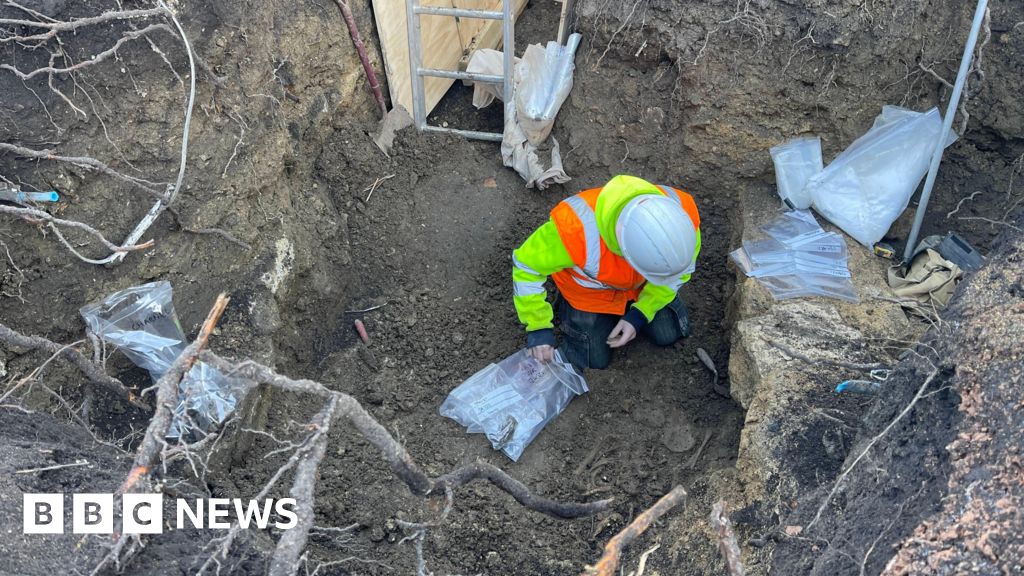 www.bbc.co.uk
www.bbc.co.uk
> Human bones dated to be more than 1,000 years old have been discovered in the garden of a hotel, with 24 skeletons found alongside bones belonging to a number of others. > >The Anglo-Saxon remains of men, women and children were found in the grounds of The Old Bell Hotel in Malmesbury, which is next door to Malmesbury Abbey, in Wiltshire. > >The remains are from 670 to 940 AD, so include the very earliest days of the abbey, when it was a monastery. > >Malmesbury Abbey historian Tony McAleavy said the results are significant, especially because the place "at this time was one of the leading centres of scholarship in western Europe". > > Malmesbury Abbey historian and local resident Tony McAleavy said he "was off the scale excited". > > "What we've got here is not a collection of the bodies of monks - it's men, women and children," he added. > > ... > > Mr McAleavy added: "It looks like we've found traces of the community of people to helped the monks here. > > "It's going to shed new light on the way Malmesbury Abbey worked in its golden age."
> The University of York’s Department of Archaeology has uncovered a large timber hall in Skipsea, dating to the early medieval period, among other finds of ‘national significance’. > > Measuring 6m wide and 16m long, the hall is a rare find, thought to predate the nearby Norman castle. Around the time the hall was constructed, the area is known to have been in the hands of Harold Godwinson, and later the Lords of Holderness. Its considerable size, marked out by post-holes, suggests a wealthy owner: the building was perhaps used to host celebrations and feasts, or may have welcomed visiting dignitaries. > > Other structures found on the site are earlier and smaller, and Dr Jim Leary, from the University of York’s Department of Archaeology, believes that they can be linked to early medieval craft-working. Among the associated finds were metalworking debris and whetstones, as well as a spindle whorl, which would indicate that textile-manufacturing was happening in the area. A partly worked jet or jet-like pendant is also evidence of early industry taking place on the site. ‘We’ll need to get the post-excavation analysis under way, and especially 14C dating, to really untangle what is associated with what,’ Dr Leary said. > > ... > > However, the archaeology being uncovered at Skipsea is not limited to the medieval period: prehistoric objects were discovered by a water channel, including two ceramic bowls and a large quantity of deer and cattle bones, which illustrates the long archaeological chronology of Skipsea’s landscape. The early history of the site was first noted by Dr Leary and Dr Elaine Jamieson, when they discovered that what was originally thought to be the motte of the Norman castle was, in fact, a reused Iron Age mound (see CA 337).
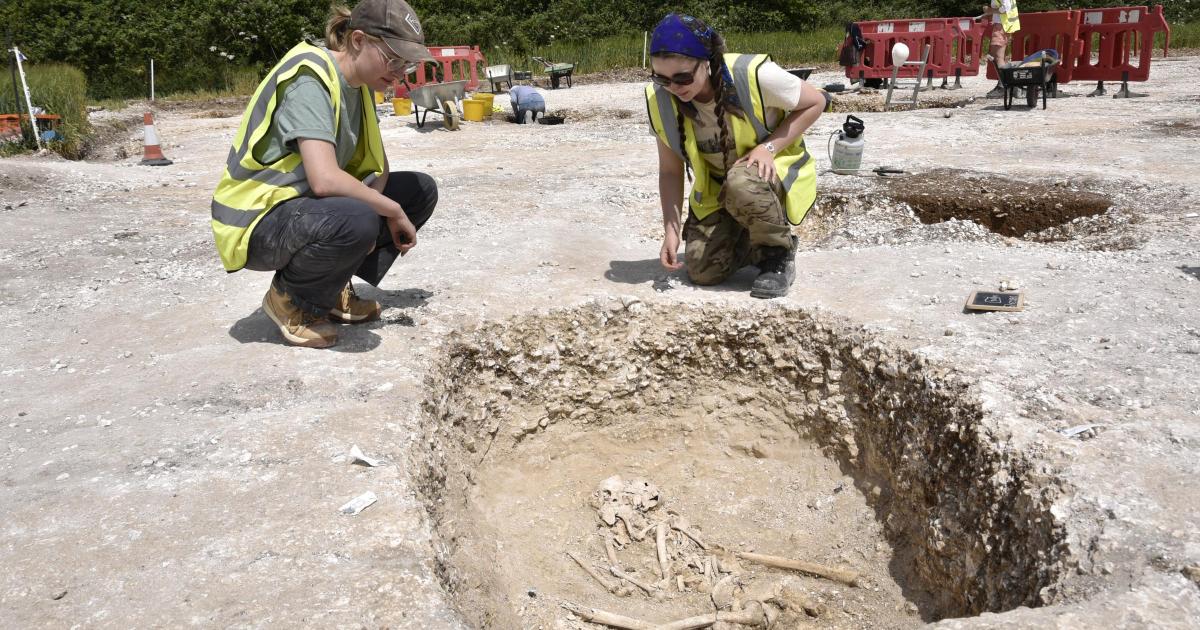 www.dorsetecho.co.uk
www.dorsetecho.co.uk
> ARCHAEOLOGISTS from Dorset have discovered human remains and artefacts which give new insight into how early Britons adapted to life after the Roman invasion. > >Amongst the grave goods excavated from the 2000-year-old burial pits and graves were Roman-style wine cups and flagons, which suggest that Mediterranean alcohol had become popular addition to British life around the time of the Roman conquest in AD 43. > >Students and staff from Bournemouth University (BU) have been excavating Iron Age settlements at the site at Winterborne Kingston for more than fifteen years. > >Whilst they have previously discovered human remains and artefacts from before the Romans arrived, these are the first finds that can tell the story of people who lived through the invasion of Dorset. > > ... > > Three graves in particular indicated the extent to which the local Durotriges tribe partially integrated into certain Roman ways of life. > > The first contained the bodies of two women, aged in their thirties who had been buried together. > > The student archaeologists found a roman-style wine flagon and goblets alongside the remains. > > “The women were buried in the traditional Iron Age way – on their side in a foetal position. So, although the grave was dug ten to twenty years after the Romans arrived, in the mid to late first century AD, it’s clear that the local people are not becoming Roman in a big way, merely taking things from the Romans that enhance and improve their life, in this instance wine.", Dr Russell explained.
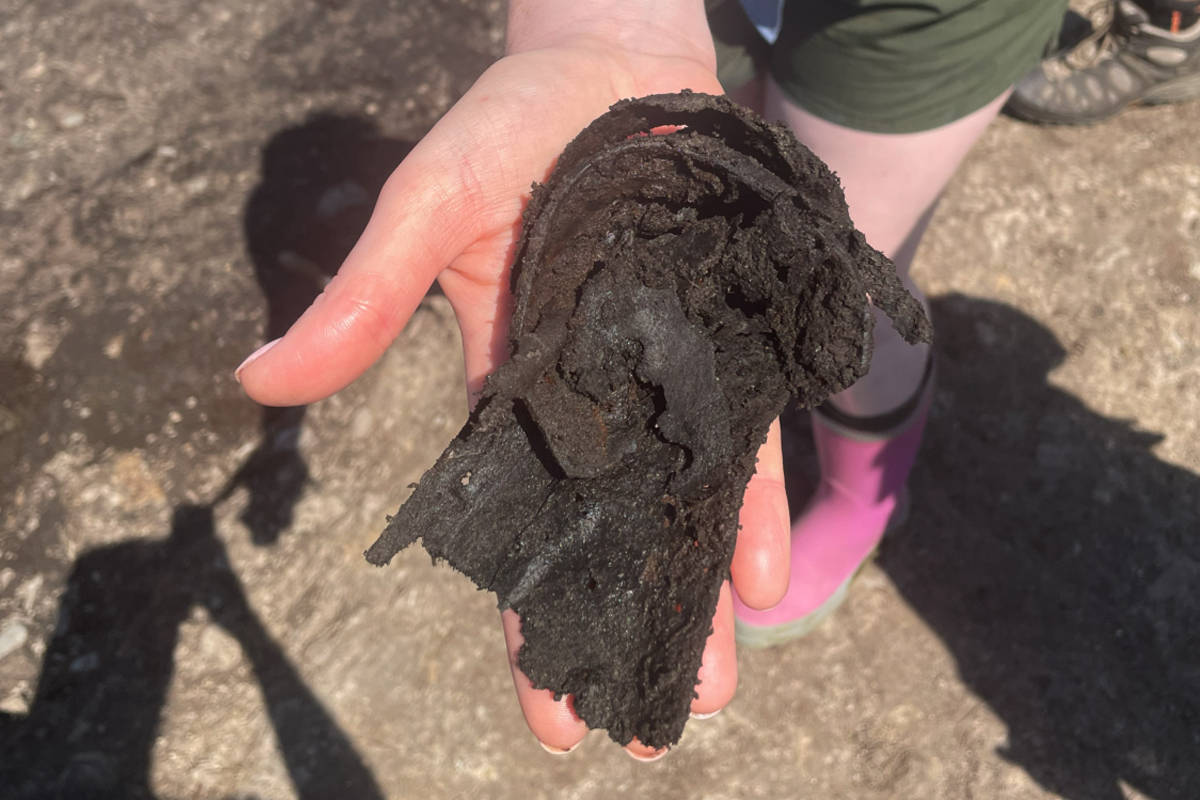 www.heritagedaily.com
www.heritagedaily.com
> Magna, also known as Carvoran, is a Roman fort situated at the edge of the Whin Sill in Northumberland, England. The fort predates the construction of Hadrian’s Wall, strategically located on the Stanegate frontier to protect the junction of the Maiden Way with the Stanegate. > >The fort was garrisoned between AD 85 and AD 122, which included the First Cohort of Syrian Archers, the Second Cohort of Dalmatians, the First Cohort of Batavians, and legionaries from the Second Augusta and the Twentieth Valeria Victrix. > > Magna is under the care of the Vindolanda Trust and operates yearly outreach excavations open to the public. In the 2024 season, volunteer archaeologists have unearthed several major findings, including squamae scales, a Roman altar, ceramics, and the remains of Roman sandals.
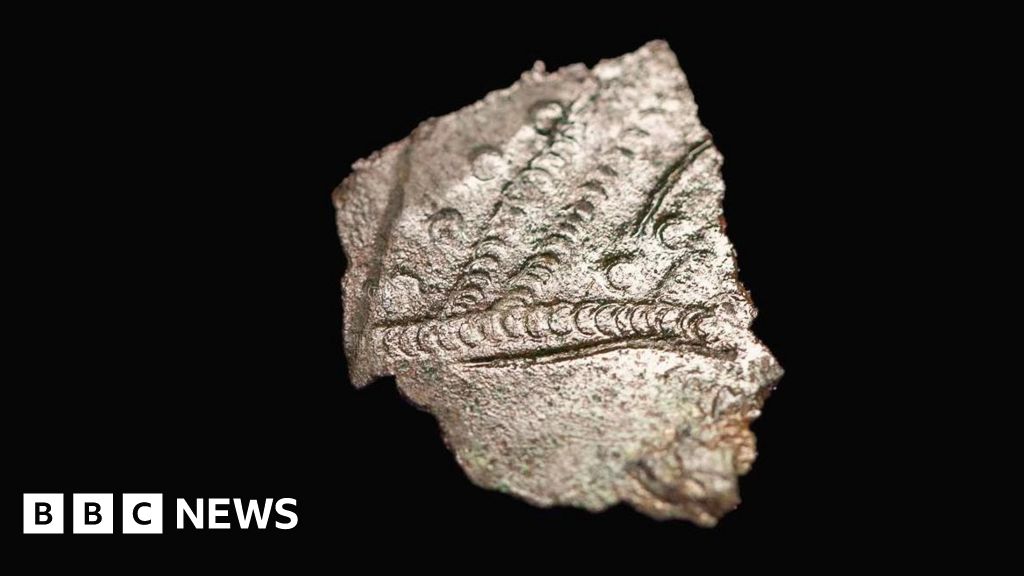 www.bbc.co.uk
www.bbc.co.uk
Missing pieces of a 6th Century Byzantine bucket have been uncovered at a site world-famous for its historical discoveries. A month-long excavation with archaeologists, conservators and volunteers from the television show Time Team has taken place at Sutton Hoo, in Suffolk. Fragments of the bucket were first discovered in 1986, with more found in 2012, the National Trust, which manages the site, said. Further pieces have now been found and experts believed the bucket had previously been damaged and repaired.
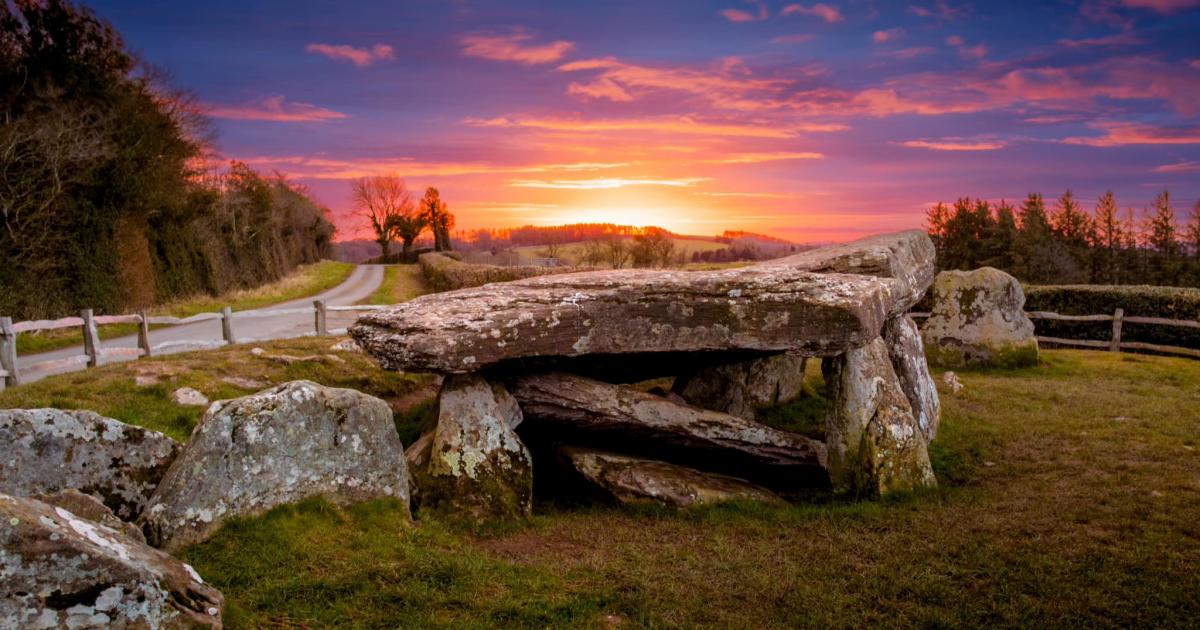 www.herefordtimes.com
www.herefordtimes.com
> A LAST chance to get up close to excavations at a mysterious Herefordshire archaeological site will be on offer this summer, as archaeologists work to solve a mystery. > > For a final summer, members of the public will get the chance to get up close to archaeological excavations being carried out at Arthur’s Stone. > > Tours of the mysterious and evocative English Heritage site in Dorstone also took place in 2022 and 2023 as part of a project to investigate early prehistoric Herefordshire, undertaken by The University of Manchester, Cardiff University and the American Institute for Field Research, in partnership with English Heritage. The project has significantly changed academic understanding of how the monument was used, and its team hope to uncover more of its secrets in 2024. > > The Neolithic burial chamber comprises nine upright stones and a gigantic 25-tonne capstone. The 5,700-year-old Golden Valley site is most famous for its links to legends of King Arthur and for being a source of inspiration for the stone table in CS Lewis’s The Lion, The Witch, and The Wardrobe. > > So far, the project has started to unravel a complex sequence of changes to the monument spanning about seven centuries in the early Neolithic (3,700 – 3,000 BCE). We now know that it started as a stone chamber or ‘dolmen’ in the 37th century BCE encircled by a thick stone ring, with an entrance on the north. It was later re-oriented to face south and remodelled within a long cairn faced by drystone walls, with a false entrance between two projecting ‘horns’ of the cairn. > > The archaeologists found evidence for an avenue of wooden posts leading to the new entrance which were replaced some centuries later with standing stones. It now looked more like the Long Barrows at Belas Knap and Stoney Littleton (also cared for by English Heritage). A narrow passage was built into one side of the cairn so that the old entrance could still be reached. Inside the passage they found pottery, bone, pitchstone from the Isle of Arran and rock crystal, probably brought from North Wales
 www.theguardian.com
www.theguardian.com
> Pembroke Castle has been a seat of power for centuries. It was the birthplace of Henry Tudor, father of Henry VIII, and is one of the country’s best preserved medieval strongholds, containing a maze of passages, tunnels and stairways, as well as a vast gatehouse tower. Scientists have discovered that the fortress has also been concealing a startling secret. A cave, known as Wogan Cavern, which lies directly underneath Pembroke Castle, has been found to contain a treasure trove of prehistoric material, including ancient bones and stone tools left behind by early Homo sapiens and possibly by Neanderthals. > > These remains will provide key information about the settling of Britain in prehistoric times, say scientists, who last week began their first major excavation of the year at Wogan. Work on the site over coming years should provide answers to major puzzles about prehistoric Britain, including the end of the Neanderthals’ occupation about 40,000 years ago. > > Early finds at Wogan include a wide range of fossils including mammoth, reindeer, and woolly rhino, as well as the remains of a hippopotamus, a species that last wallowed in British waters 125,000 years ago. Archaeologists have also found that much of the cavern’s floor is covered with a layer of stalagmite which has preserved the soil, bones, proteins and DNA that lie below. > > “The site has got fantastic potential,” said Prof Chris Stringer of the Natural History Museum, London. “It’s the best prospect that we have got in providing fresh material that can help us find out how Neanderthals lived in Britain and learn how they were replaced by Homo sapiens.”
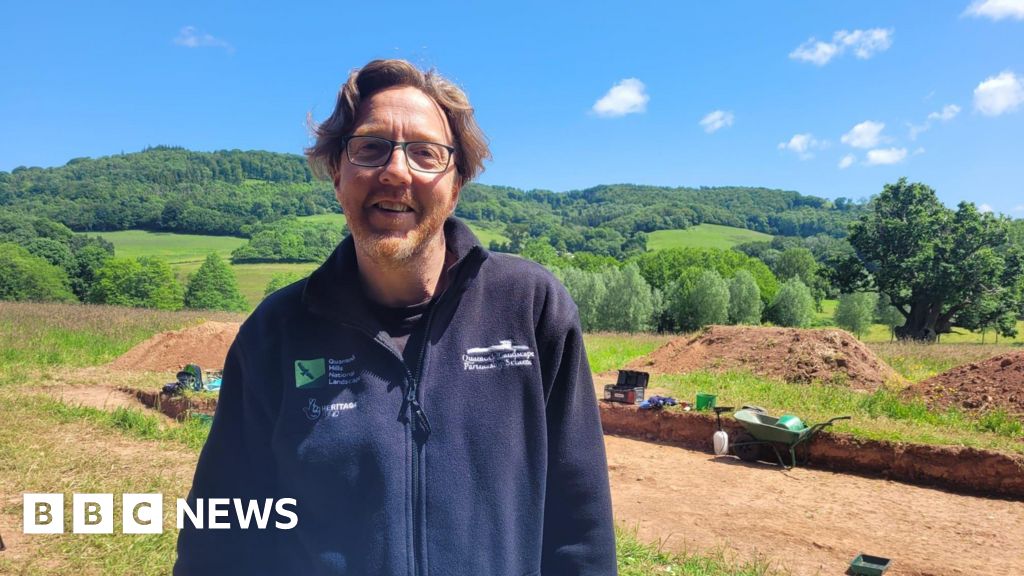 www.bbc.com
www.bbc.com
> A team of professional and amateur archaeologists has been digging for prehistoric, Roman, medieval, and Georgian remains. > > The dig at Cothelstone Farm in the Quantocks is funded by the National Lottery Heritage Fund and gives volunteers the opportunity to learn how to excavate a site. > > The site was significant to people during the Bronze Age right up until medieval times, archaeologists said. > > Dan Broadbent, historic heritage officer for the Quantock Landscape Partnership Scheme, said: "What makes it so special is the idea that you have a single place looking out at this fantastic view which was clearly important for people in the past over a long period." > > The scheme, alongside charity DigVentures, organised the dig after seeing aerial images of the site which showed "potential features". > > ... > > "As the story has evolved, we discovered that the ring ditch was probably visible into medieval times, the Romans would have seen it, the Anglo-Saxons would have seen it, so being able to tell that story has been very cool." > > The ring ditch was likely a ceremonial site during the Bronze Age.
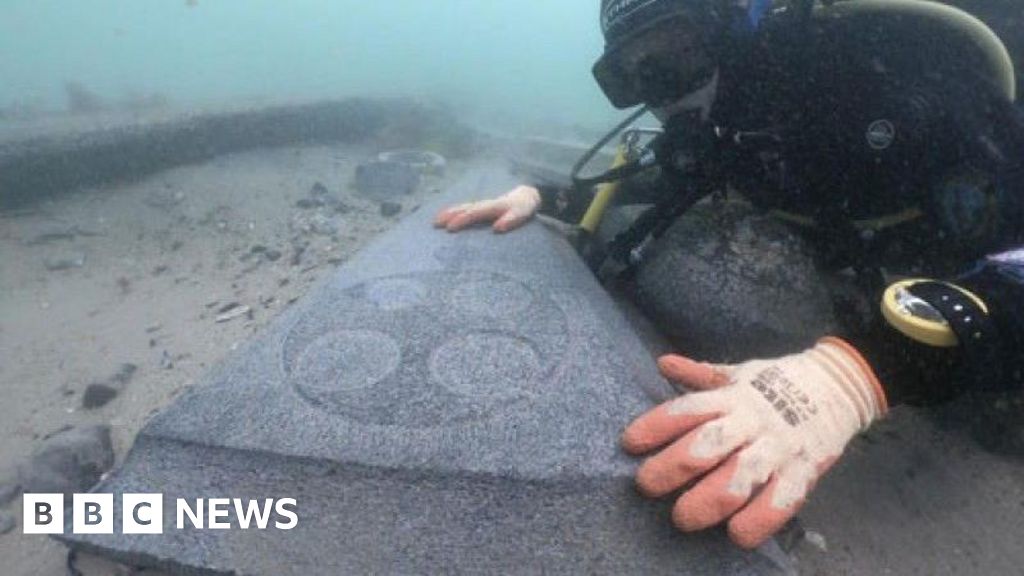 www.bbc.com
www.bbc.com
> A number of grave slabs from England's oldest known shipwreck have been recovered by maritime archaeologists. > > The remains of the 13th Century Mortar Wreck were discovered in Poole Bay, off Dorset, in 2020. > > Cauldrons, cups, pottery and kitchen objects have already been brought to the surface. > > A team from Bournemouth University has returned to the site to raise the carved slabs, along with stone mortars - made for grinding flour. > > Dr Derek Pitman, head of archaeology at the university, said the wreck was "really well preserved". > > "It was full of stone mortars and burial slabs. I've never seen anything like it," he said. > > "It probably hit some choppy waters as it was leaving the harbour. > > "It's a substantial ship and had a relatively large cargo."
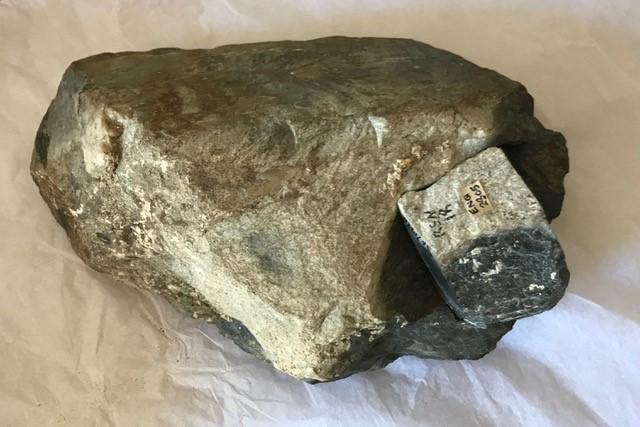 www.salisburyjournal.co.uk
www.salisburyjournal.co.uk
> A “lost” boulder rediscovered in a box in Salisbury Museum has provided powerful evidence that the bluestones of Stonehenge were transported from West Wales by glacier ice. > > The evidence also makes it clear that the story of the transport of 80 bluestones by heroic Neolithic tribesmen, one of the great Stonehenge myths should now be dumped. > > New research, published today in the International Quaternary Science Journal, describes in detail the surface characteristics of the boulder, which suggest that it has had a complex history beginning with glacial entrainment and transport in North Pembrokeshire and ending at Stonehenge with human damage in Neolithic and modern times.
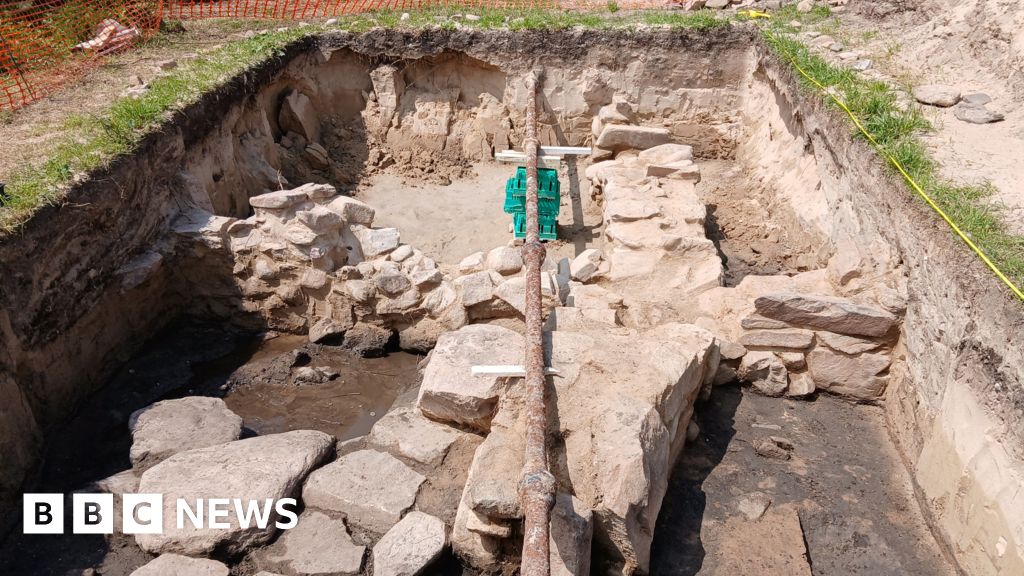 www.bbc.com
www.bbc.com
> Dig Alderney has discovered part of an Iron Age round house in its latest excavation. > > Initially, the most recent dig had not revealed much archaeology but this latest find will offer a target for future excavations. > > The team was hoping to find more evidence of Iron Age and Roman Alderney in the trio of trenches that they opened on Les Hugettes. > > A pair of trenches were also positioned along Les Mielles to seek more of the large Roman building discovered in 2017. > > Dr Jason Monaghan said: "What came as a surprise was the very late date of the pottery found beneath the floors of the building. > > "It seems that it was not constructed until the 4th Century AD and was modified even later by the addition of crude drystone walls. > > "Some of the pottery in the latest layers may prove to be post-Roman." > > Other finds from this dig include 850 shards of Roman pottery with most from the 3rd and 4th Century, a bronze coin - of the Emperor Valens AD364-367 and a silver coin of Caesar Valerian II AD255.
 www.bbc.com
www.bbc.com
> A major research project will take place to "reach the undisturbed archaeology" at a site famous for unearthing an Anglo Saxon burial ship. > > The National Trust, which owns the site, said the two-year research project at Sutton Hoo near Woodbridge, Suffolk, will aim to grow its understanding of the land. > > ... > > The excavation will be filmed by Time Team as a series exclusive for a documentary special, hosted by Sir Tony Robinson. > > The project, which starts in June, will build on work carried out by Time Team in 2021 and 2023. > > Mr Wainwright said previous work by Time Team identified mysterious features in Garden Field, Sutton Hoo. > > "We know from previous work in this field, it’s likely we will find prehistoric flint tools and fragments of Anglo Saxon objects from burials scattered through the plough soil, but working out what the mysterious geophysical anomalies are will be our focus."
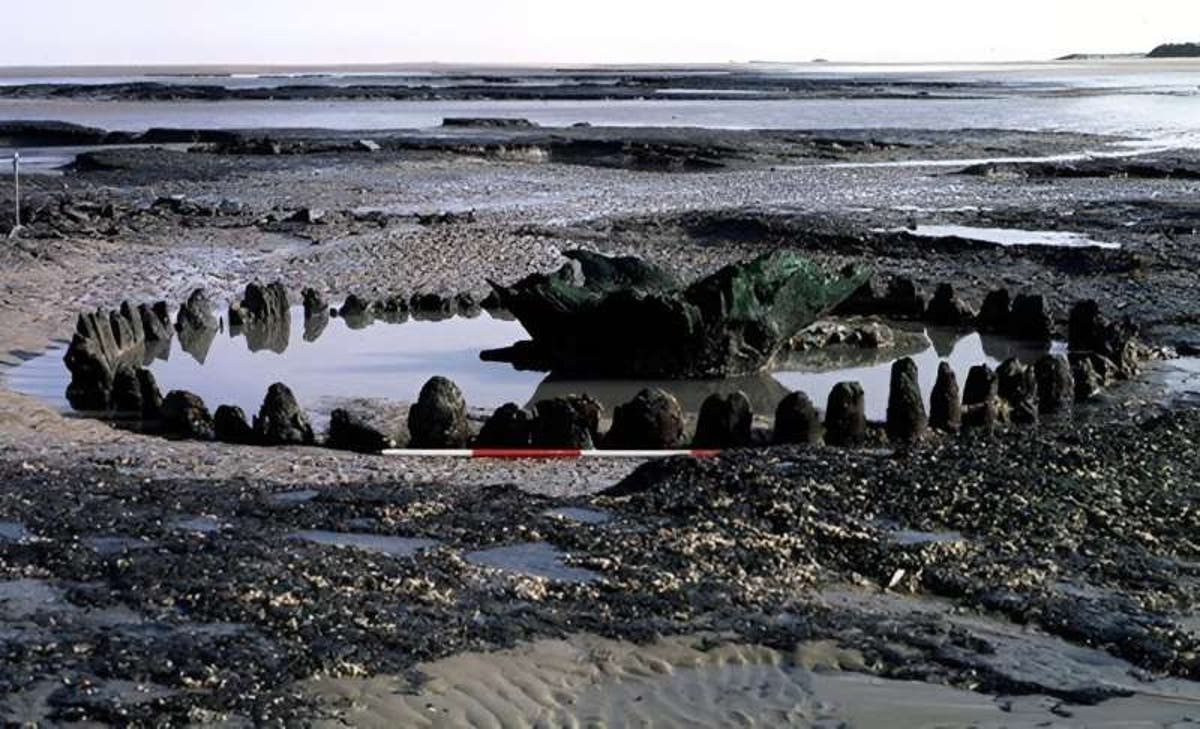 www.independent.co.uk
www.independent.co.uk
> The mysterious ancient structure was first revealed in 1998 by the shifting sands of Holme-next-the-sea beach on the north Norfolk coast. > > It consists of an upturned tree stump surrounded by 55 closely fitted oak posts and was originally built on the salt marsh away from the sea. > > Researchers estimate it to have been built using timbers dating from 2049 BC. > > The strange structure was positioned such that dunes and mud flats protected it from the sea. > > A layer of peat which slowly covered the timbers also protected them from decay over thousands of years. There is a second, adjacent ring centred on two oak logs laid flat, which is also dated to the same year. > > ... > > Now, a new paper concludes that the Seahenge and the adjacent circle may have been constructed during a bitterly cold climatic period as a ritual to extend the summer and return to warmer weather. > > “Dating of Seahenge timbers showed they were felled in spring, and it was considered most probable that these timbers were aligned with sunrise on the summer solstice,” archaeologist David Nance from the University of Aberdeen said. > > “We know that the period in which they were constructed 4,000 years ago was a prolonged period of decreased atmospheric temperatures and severe winters and late springs placing these early coastal societies under stress,” he said. > > The Seahenge’s alignment matches with sunrise on the summer solstice, suggesting it mimicked the “pen” described in folklore for an unfledged cuckoo to keep singing and extend the summer. > > Archaeologists suspect that the strange monument’s structure imitates the winter dwellings of the cuckoo remembered in folklore – a hollow tree or ‘the bowers of the Otherworld’ represented by the upturned oak stump at its center. > > “Summer solstice was the date when according to folklore the cuckoo, symbolising fertility, traditionally stopped singing, returned to the Otherworld and the summer went with it,” Dr Nance explained. > > “The ritual is remembered in the ‘myth of the pent cuckoo’ where an unfledged cuckoo was placed into a thorn bush and the bird was ‘walled-in’ to extend the summer but it always flew away,” he said. > > The other structure, according to Dr Nance, points to legends of ‘sacred kings’ who were sacrificed if misfortune fell on the community. > > “Evidence suggests that they were ritually sacrificed every eight years at Samhain (now Halloween) coincident with the eight-year cycle of Venus,” he said. > > “Both monuments are best explained as having different functions and associated rituals, but with a common intent: to end the severely cold weather,” Dr Nance said.
